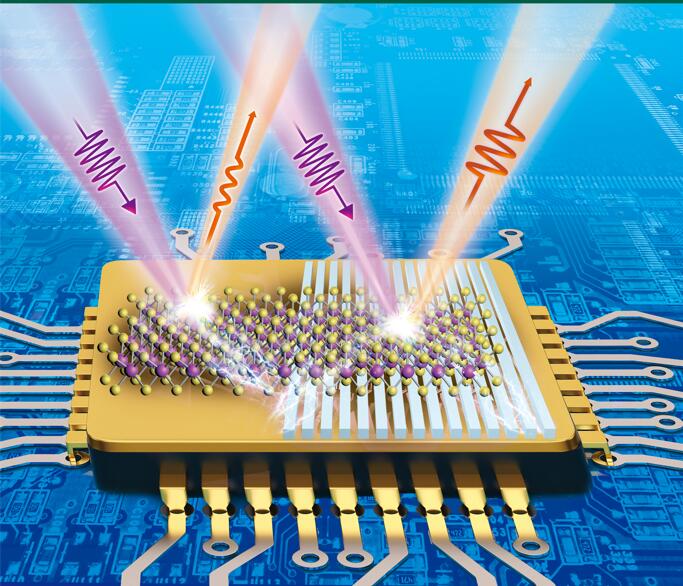VIEWS AND PERSPECTIVES
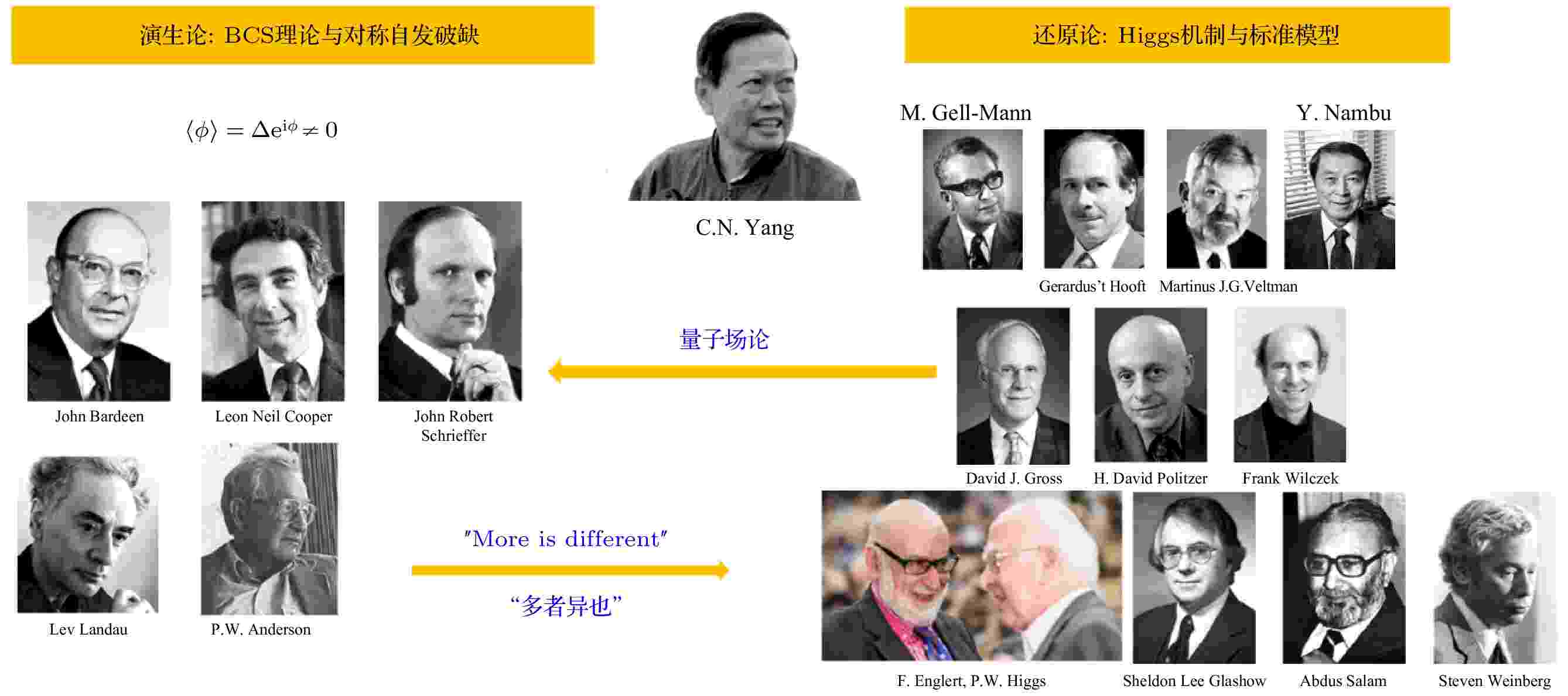
VIEWS AND PERSPECTIVES
2022, 71 (1): 010101.
doi: 10.7498/aps.71.20212307
Abstract +
On the occasion of the centennial birthday of Mr. Chen-Ning Yang, many articles have summarized his important scientific influences on the development of contemporary physics. The author thinks that, as one of the greatest theoretical physicists, Mr. Yang in many scientific contributions has promoted the revolutionary progress of physics, and his unique style of science with deep and meaningful thoughts in academia has a long-term inspiration on developments of physics. Learning from Chen-Ning Yang's scientific thoughts, the author will put forward some personal opinions on the development trend of theoretical physics with his own experiences in researching theoretical physics for 30 years, e.g., studies of quantum open system, superconducting phase transition and cold atom physics by following Mr. Yang in Stony Brook from 1992 to 1994. This article will elaborate why it is important to pursue “beautiful or useful” theoretical physics through some concrete illustrations; Why could the good theories in fundamental physics be kept at a distance from experiments for some time? For the latter, this article also argues the relationship between theoretical prediction and experimental confirmation from the perspective of scientific methodology (philosophy). Focusing on “useful” theoretical physics-the applied theoretical physics, the author emphasizes that scientific research driven by the national demand, as well as free exploration, can also lead to important breakthroughs in fundamental physics.
SPECIAL TOPIC—Nano engineering and thermophysics
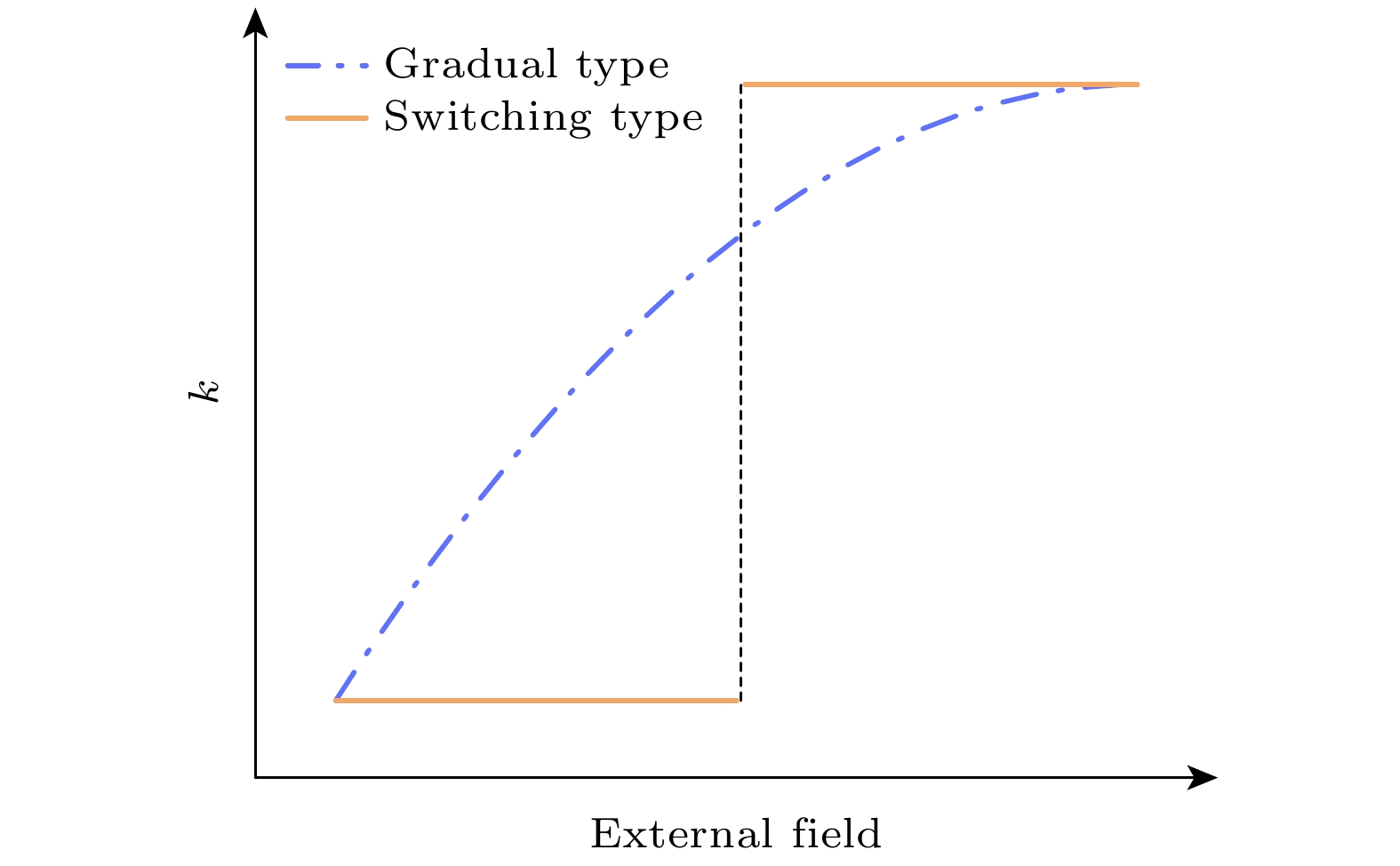
EDITOR'S SUGGESTION
2022, 71 (1): 014401.
doi: 10.7498/aps.71.20211889
Abstract +
Effective thermal control technologies are increasingly demanded in various application scenarios like spacecraft systems. Thermal conductivities of materials play a key role in thermal control systems, and one of the basic requirements for the materials is their reversibly tunable thermal properties. In this paper, we briefly review the recent research progress of the thermal smart materials in the respects of fundamental physical mechanisms, thermal switching ratio, and application value. We focus on the following typical thermal smart materials: nanoparticle suspensions, phase change materials, soft materials, layered materials tuned by electrochemistry, and materials tuned by specific external field. After surveying the fundamental mechanisms of thermal smart devices, we present their applications in spacecraft and other fields. Finally, we discuss the difficulties and challenges in studying the thermal smart materials, and also point out an outlook on their future development.
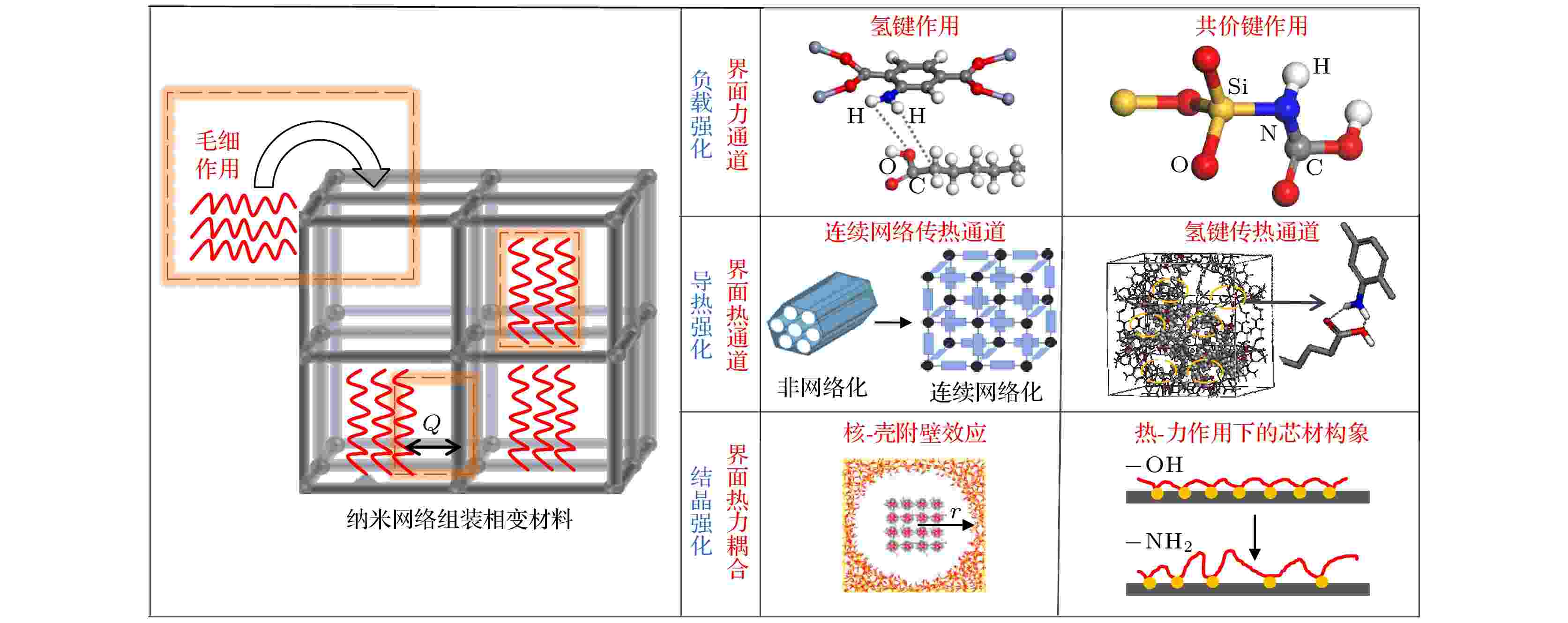
COVER ARTICLE
2022, 71 (1): 016501.
doi: 10.7498/aps.71.20211776
Abstract +
The present paper briefly reviews the development progress of solid-liquid phase change materials, particularly the nano-porous shape-stabilized phase change materials. We outline the designs and syntheses of the heat storage functional materials and the thermophysical mechanism of loading, crystallization, and thermal transport in nano-confined space. Besides, the remarkable methods to enhance the heat storage and release performance of heterogeneous materials are included. However, at present, the single-size porous materials cannot satisfy the requirements for high heat storage/release rate and great thermal energy density simultaneously. Based on this, the novel hierarchical porous frameworks materials are explored to overcome these obstacles. For this purpose, some scientific problems, opportunities, and challenges are summarized at the end of this paper.
GENERAL

2022, 71 (1): 010301.
doi: 10.7498/aps.71.20211212
Abstract +
The squeezed state, as an important quantum resource, has great potential applications in quantum computing, quantum communication and precision measurement. In the noncritically squeezed light theory, the predicted noncritically squeezed light can be generated by breaking the spontaneous rotational symmetry occurring in a degenerate optical parametric oscillator (DOPO) pumped above threshold. The reliability of this kind of squeezing is crucially important, as its quantum performance is robust to the pump power in experiment. However, the detected squeezing degrades rapidly in detection, because the squeezed mode orientation diffuses slowly, resulting in a small mode mismatch during the homodyne detection. In this paper, we propose an experimentally feasible scheme to detect noncritically squeezing reliable by employing the spatial mode swapping technic. Theoretically, the dynamic fluctuation aroused by random mode rotation in the squeezing detection can be compensated for perfectly, and 3 dB squeezing can be achieved robustly even with additional vacuum noise. Our scheme makes an important step forward for the experimental generation of noncritically squeezed light.
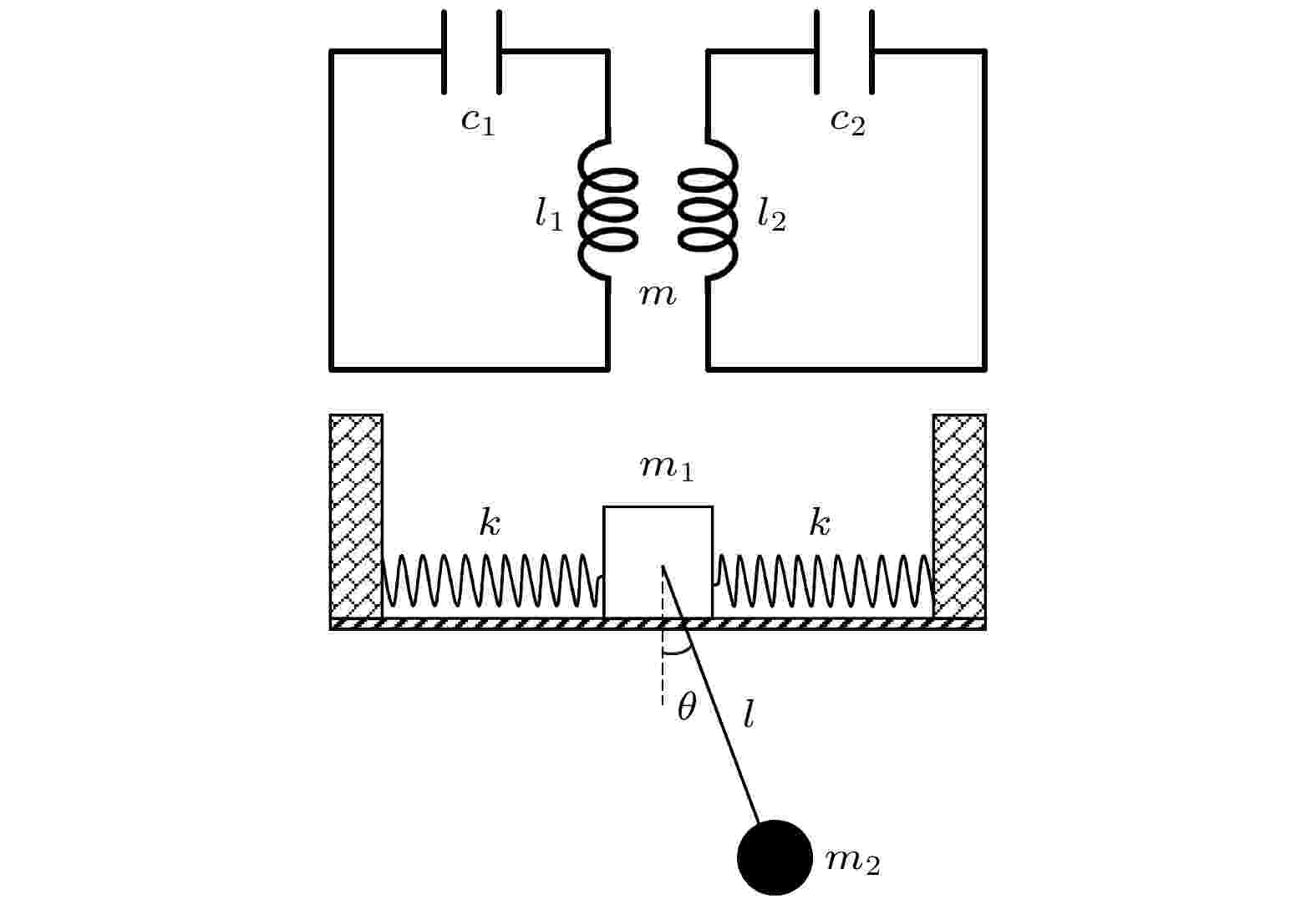
2022, 71 (1): 010302.
doi: 10.7498/aps.71.20210992
Abstract +
Since the birth of quantum mechanics, its classical correspondence (or analogy) has been a hot topic for physicists. In this paper, we first discuss whether there is a classical correspondence of quantum entanglement. We give a positive answer through the following examples: in the framework of quantization of mesoscopic circuits, two mesoscopic capacitance inductance (LC) circuits with mutual inductance are proved to be the source of quantum entanglement by using the integration within an ordered product, and then the formula of their characteristic frequency is obtained, It is found that it is similar to the expression of the small oscillating frequency of a classical system described below. The classical system is shown in Fig. 1 . Two walls are connected with the same spring. And between the two springs a sliding trolley can move on a smooth table. The trolley is hung with a simple pendulum, The small oscillating frequency of the system is calculated by analytical mechanics. It is found that the swing of the simple pendulum will cause the trolley to oscillate back and forth. The mutual restraint effect of the pendulum, the trolley and the spring reflects the “entanglement” between them.

EDITOR'S SUGGESTION
2022, 71 (1): 010303.
doi: 10.7498/aps.71.20211121
Abstract +
Entangled state quantum detection is a new technology that combines quantum mechanics with information science, and is used in the field of target detection. It has the potential to break through traditional detection technologies in terms of sensitivity and anti-interference ability. In the field of radar detection, constant false alarm rate is a technology with important significance and application value. However, there is no research on the method of the constant false alarm rate in the entangled state quantum detection system. Aiming at this problem, in this paper a method of constant false alarm rate for the entangled state quantum detection system is proposed. In the proposed method the system's real-time estimation of noise is adopted, and the detection threshold is adjusted adaptively, so that the entangled state quantum detection system always maintains a constant false alarm rate. The simulation results show that the proposed method of constant false alarm rate is correct and effective, and can realize the function of the constant false alarm rate of the entangled state quantum detection system. The proposed method effectively improves the flexibility and adaptability of the quantum detection system, and provides a solid theoretical foundation for the practical application of entangled state quantum detection technology.
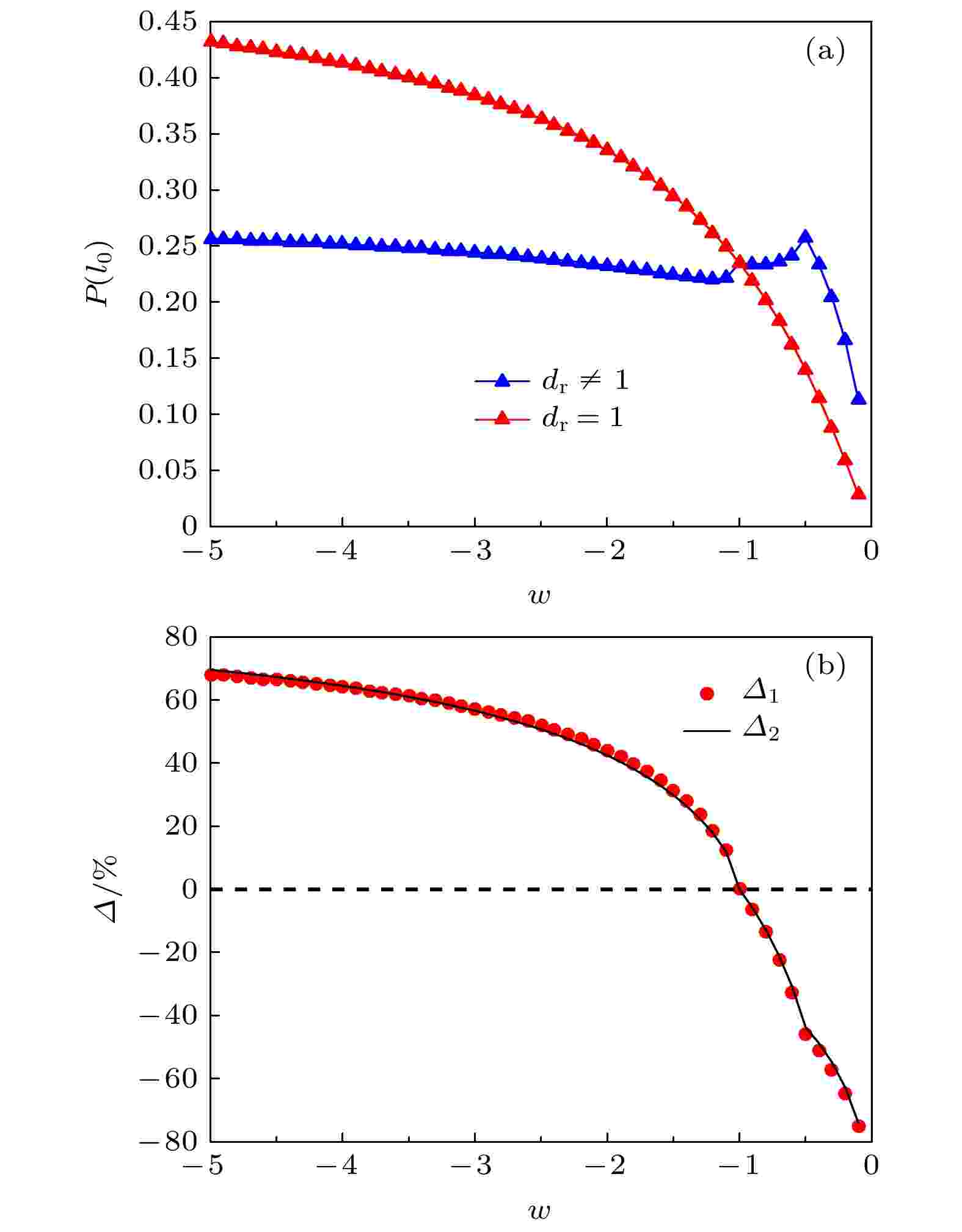
2022, 71 (1): 010304.
doi: 10.7498/aps.71.20211146
Abstract +
The effect of the turbulent motion of ocean on the quantum communication based on the orbital angular momentum in an underwater quantum channel is studied in this work. Based on the power spectrum model of ocean turbulence proposed by Elamassie, the quantitative relationships of different ocean turbulence parameters with the single photon detection probability of orbital angular momentum photons, the channel capacity, the key generation rate, the concurrence of two entangled photons are proposed. The maximum entanglement distance of the orbital angular momentum entangled photon-pairs in the ocean turbulence is further studied by the universal entanglement decay of the concurrence of entangled photon-pairs in the ocean turbulence. The results show that the detection probability of single photon, the channel capacity, the key generation rate, and the concurrence of entangled photon-pairs decrease with the increase of the dissipation rate of turbulent kinetic energy and the decrease of the rate of dissipation of mean-squared temperature. The influence of the temperature and salinity balance parameter of ocean turbulence on the performance of underwater quantum communication are significantly different under the condition of whether the stable stratification of seawater is assumed or not. In the ocean turbulent environment, the increasing of the initial orbital angular momentum quantum number of signal photons can improve the key generation rate of quantum key distribution and the resistance of entangled photons to entanglement decay.
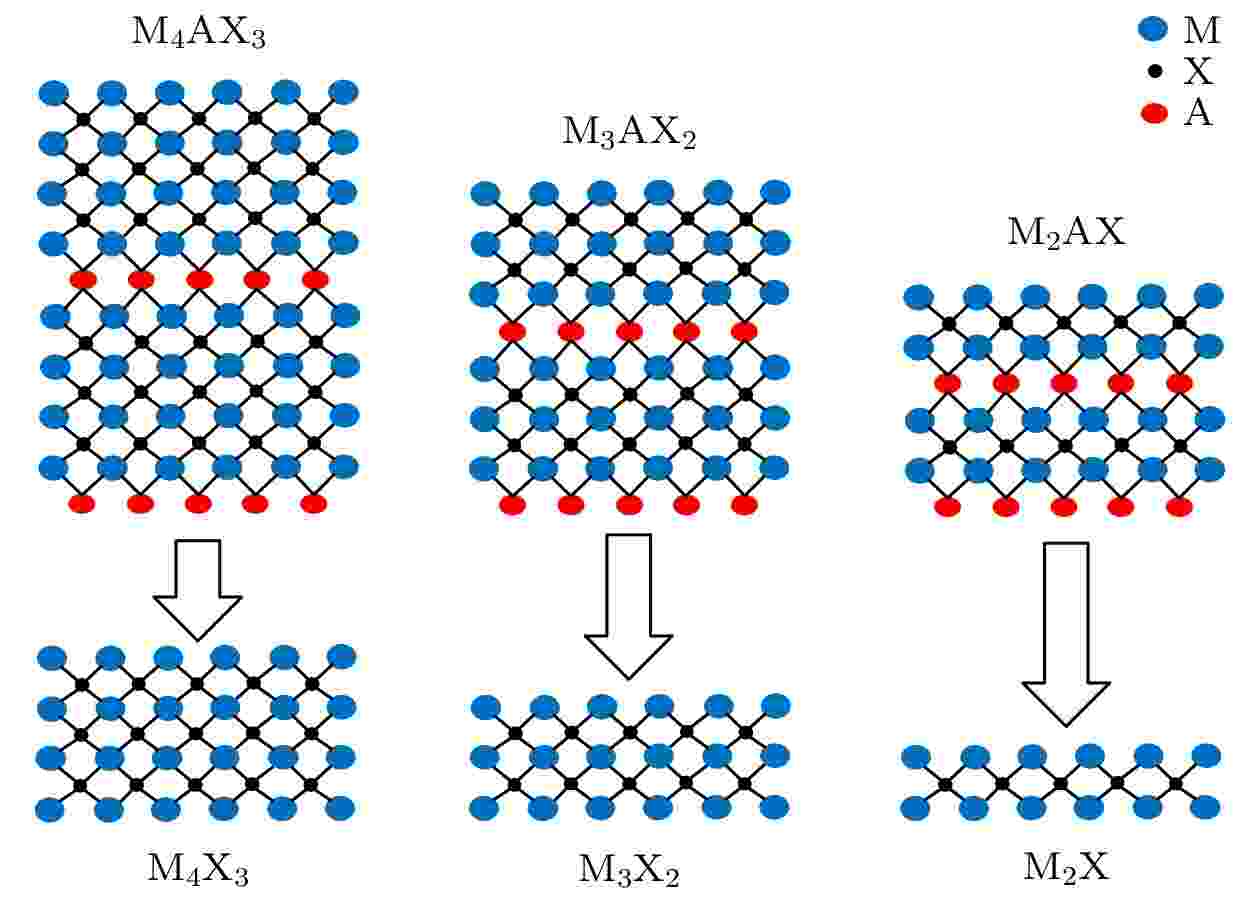
2022, 71 (1): 010701.
doi: 10.7498/aps.71.20211048
Abstract +
Since the discovery of graphene materials, two-dimensional materials have been widely recognized and gradually applied. Two-dimensional transition metal carbides (MXenes) have better mechanical, magnetic and electrical properties than traditional two-dimensional materials. In this work, Ti3C2Tx samples are prepared by etching Ti3AlC2 with different etching agents for the solutions of HF and LiF/HCl. The effects of etching agents on the structure and gas sensing properties of Ti3C2Tx materials are studied by scanning electron microscopy (SEM), X-ray photoelectron spectroscopy (XPS), and gas sensing properties analysis. The material structure analysis shows that both HF and LiF/HCl etching agents have good etching effect on Ti3C2Tx material. The results of gas sensing properties show that the gas sensing properties of Ti3C2Tx prepared by LiF/HCl etching agent is better than by HF etching agent, and the wide range, high sensitivity and high stability of NH3 detection can be achieved at room temperature. The analysis shows that the high sensing performance of Ti3C2Tx prepared by LiF/HCl solution etching is mainly due to the high proportion of —O and —OH functional groups on the surface of Ti3C2Tx. The experimental studies can lay a theoretical foundation for studying the gas sensing and practical application of Ti3C2Tx based sensor.
NUCLEAR PHYSICS
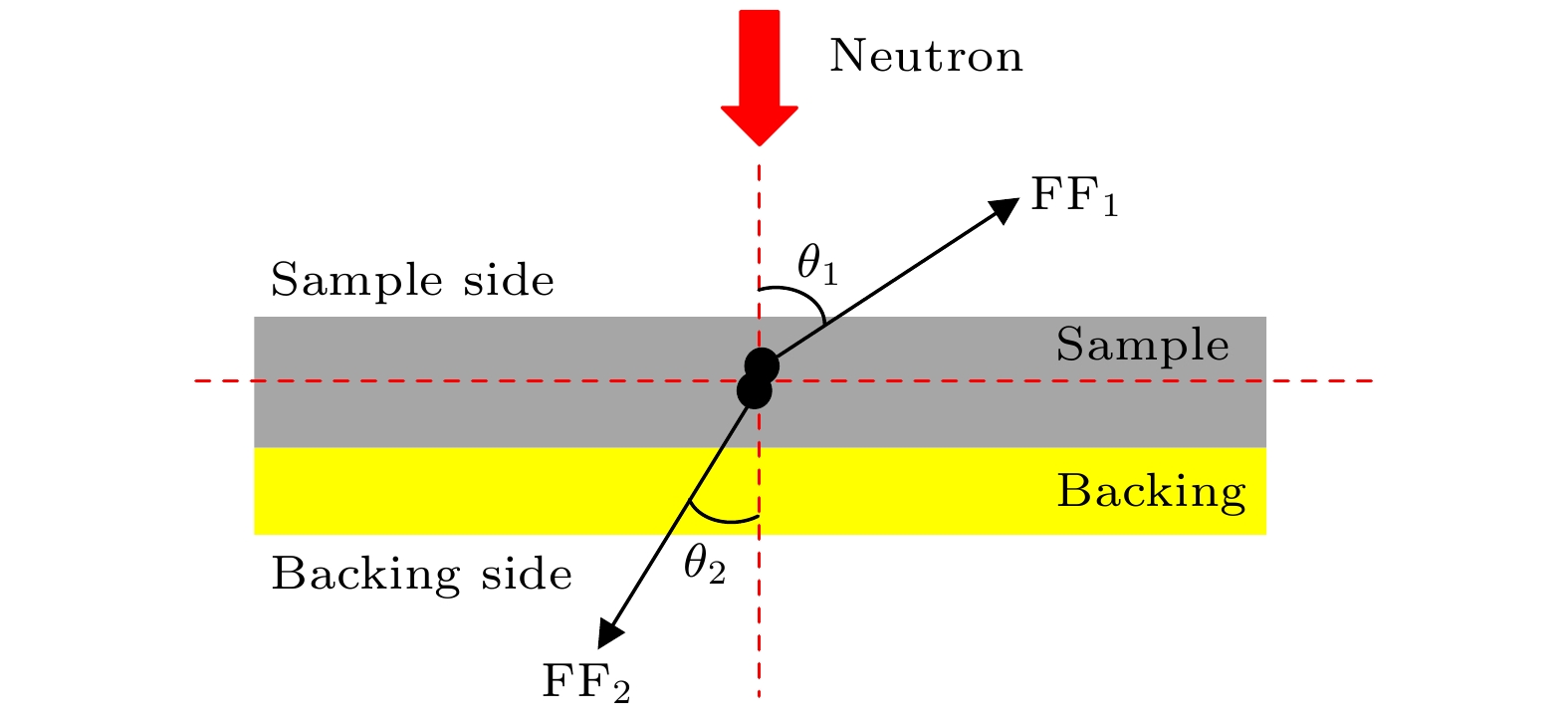
2022, 71 (1): 012501.
doi: 10.7498/aps.71.20211333
Abstract +
The development of fourth-generation reactors and advanced nuclear energy systems require high-precision, multi-nuclide, and wide-energy-area neutron nuclear data. However, the current nuclear energy-related nuclear fission data in the China Nuclear Data Evaluation Library (CENDL library) are incomplete and cannot meet the current need. It is extremely important to establish the reliable calculation methods and tools for the neutron nuclear data. Based on the Monte-Carlo method, a model for calculating the pre-neutron fission fragment is established in this work. The mass and kinetic energy distribution of 232Th(n,f) reaction at the medium- and low- incident neutron energy are studied. The calculations of the mass distribution with the different values of incident energy are compared with the experimental results. The maximum deviation of this work from the experimental data is ~1%, which is advantageous compared with the GEF and TALYS code (maximum deviation from the experimental value is ~2%). The calculation of the pre-neutron fission fragment kinetic energy also shows good agreement with experimental result. The results indicate that this model can well describe and predict the characteristics of pre-neutron fission fragment for 232Th(n,f) reaction at the medium- and low- incident neutron energy. It also provides a new idea for calculating the neutron-induced actinide fission reactions.

2022, 71 (1): 012901.
doi: 10.7498/aps.71.20211374
Abstract +
Laser fusion research needs much more high-time-resolved diagnostic technologies to study the dynamic process in laser plasma. We develop a special method and setup a device to measure the electromagnetic field in the plasma by using a single electron bunch. The measurement covers the whole-time window of the plasma process driven by a 3.6 ns laser pulse. An electron source can generate a single electron bunch with 0–100 keV energy and 10ns bunch length. A laser pulse with 1 J energy and 532 nm wavelength irradiates on the edge of a silver target, the target nearby the irradiated spot is ionized into plasma. At the beginning of plasma generation, the head of the electron beam begins to pass through the plasma. Electromagnetic field in plasma pushes the electrons transversely. A high voltage pulse at a good time is used to deflect the electrons linearly in the transverse direction to avoid overlapping of the different electrons on the scintillator downstream. By analyzing the deflection distances of the different electrons in this single bunch, we succesfully achieve an average electronic field along the trajectory in the plasma in the whole plasma process. The maximum value of this electronic field is $ 7.74\times {10}^{5}\;\mathrm{V}/\mathrm{m} $ .
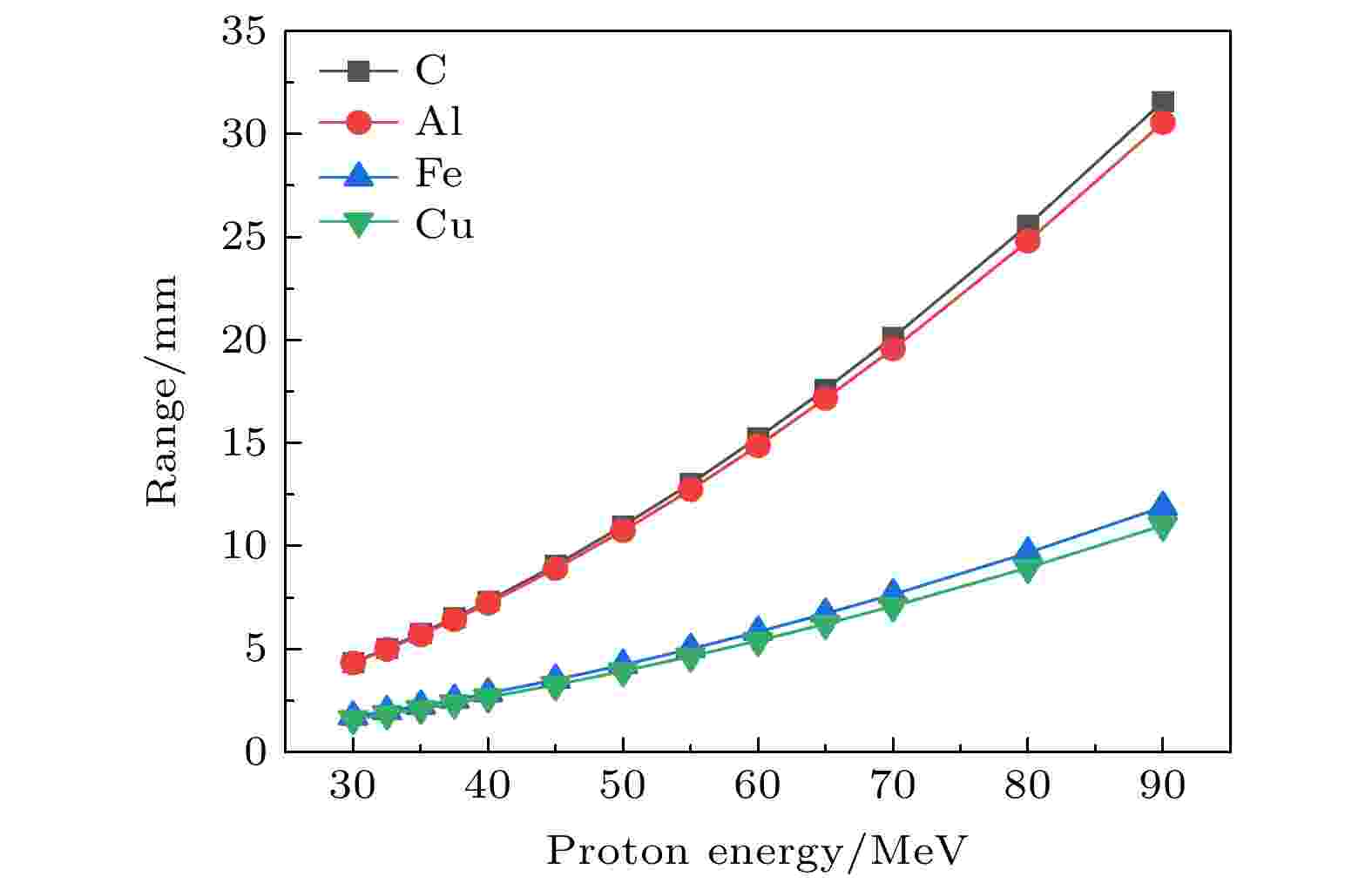
2022, 71 (1): 012902.
doi: 10.7498/aps.71.20211561
Abstract +

2022, 71 (1): 012903.
doi: 10.7498/aps.71.20211062
Abstract +
Silicon drift detector (SDD) is a kind of high performance X-ray detector, which is widely used. The ray detection system based on SDD is composed of SDD device, preamplifier and pulse processing system. The now available pulse processing system has the problems of poor pulse pile-up rejection performance and being vulnerable to the parameter fluctuations of front-end system, which degrades the performance of detection system. A digital pulse processing system is proposed. In this system, analog-to-digital converter (ADC) directly samples the output signal of preamplifier, and transmits the data to the digital pulse processing platform for processing. According to the signal characteristics of SDD device and preamplifier, the influence of ADC sampling bits and sampling frequency on system performance is analyzed. Two optimized ADC sampling circuits are proposed to reduce energy resolution degradation induced by insufficient ADC sampling bits. The pulse shaping algorithm in the digital pulse processing system is studied. The results show that the shaping signal will not be distorted due to the parameter fluctuations of the front-end system, which proves the robustness of the digital pulse processing system. The digital pulse processing system is implemented and tested, and the correctness of the system is verified.
ELECTROMAGNETISM, OPTICS, ACOUSTICS, HEAT TRANSFER, CLASSICAL MECHANICS, AND FLUID DYNAMICS
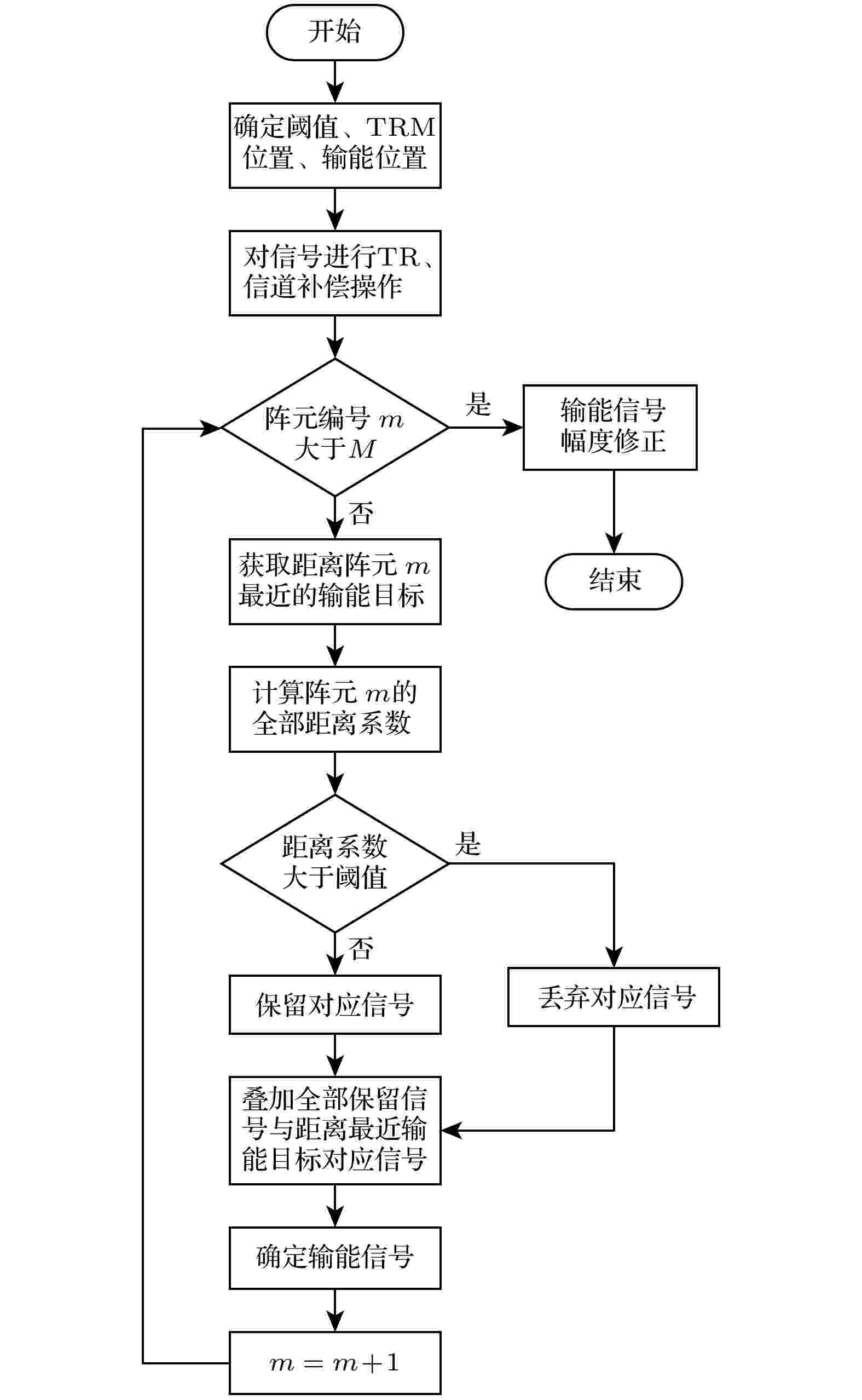
2022, 71 (1): 014101.
doi: 10.7498/aps.71.20211231
Abstract +
The precise, uniform and constant wireless transmission of electromagnetic power to multiple targets in a local finite space is a scientific problem to be solved urgently. Aiming at this problem, in this paper we propose an automatic zone selection channel matching method based on time reversal technique which has the spatiotemporal focusing characteristics. The proposed method can not only adaptively compensate for the channel differences at different targets based on the contribution rate of the multipath signals, but also dynamically divide the working range of the time reversal mirror elements to eliminate the mutual influences between different targets through the use of the distance coefficient. While improving the accuracy of energy focusing, the proposed method also solves the problem that non-uniform microwave power transmission (MPT) of multiple targets, and therefore achieving the constant, uniform and long-time MPT of multi-targets.
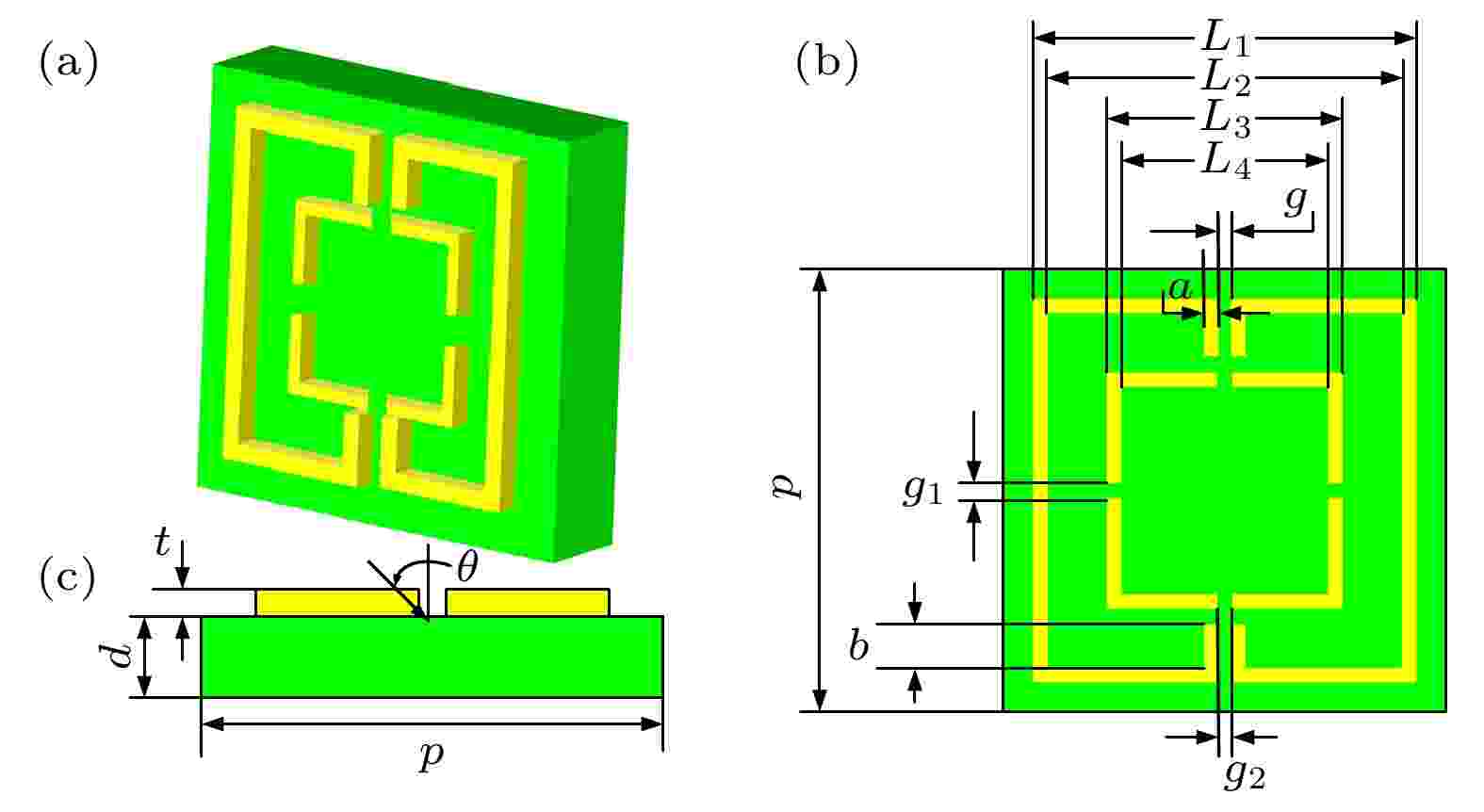
2022, 71 (1): 014201.
doi: 10.7498/aps.71.20211312
Abstract +
In this paper, a metamaterial structure with a double-layer split square ring and a double C-shaped structure is designed, which has dual-band electromagnetically induced transparency effects in the terahertz band. This structure has transmission peaks at 1.438 THz and 1.699 THz. Through the analysis of the surface current distribution, the reasons for the dual-band electromagnetically induced transparency are discussed. The effect of the designed metamaterial on the transmission window is studied when the opening size of the open square ring and the distance of the double C-shaped structure and the incident angle are changed. At an incident angle, the transmission spectrum of the designed material changes greatly, implying that it is highly sensitive to angle. The research results show that the structure has potential applications in sensors and angle filters.
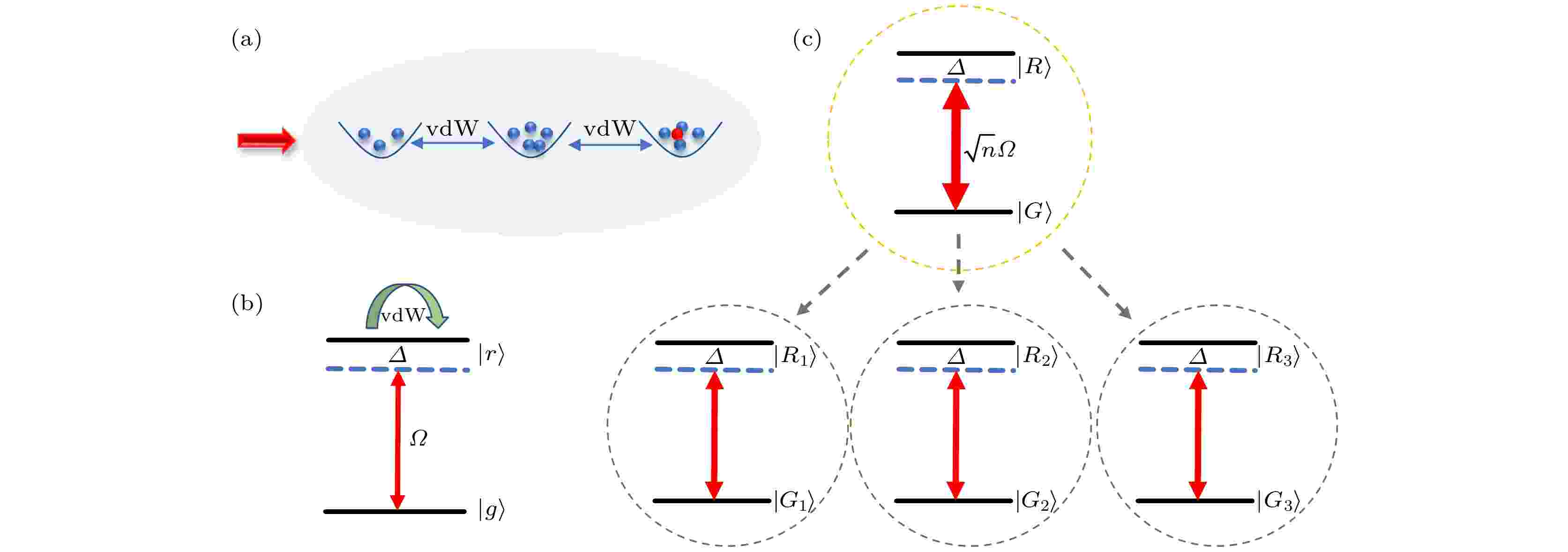
2022, 71 (1): 014202.
doi: 10.7498/aps.71.20211284
Abstract +
Owing to the long lifetime of Rydberg atom, easy to operate and easy to control the interaction between Rydberg atoms, Rydberg atom has attracted considerable attention in quantum information and quantum optics fields. Specially, the anti-blockade effect, as a physical resource, can be used to implement various tasks in quantum information processing. Based on the rigid dipole blockade, an ensemble of two-level Rydberg atoms trapped in three magneto-optical traps can be regarded as a superatom. Based on the superatom model, the in-phase and anti-phase dynamics of the three-body Rydberg superatoms are studied by adjusting the numbers of atoms, and the W state and two kinds of maximal entangled states are generated simultaneously. Our work has great potential applications in coherent manipulation and quantum information processing.The numerical simulations are performed based on the superatom model and thereby the formidable obstacle that the Hilbert space dimension grows exponentially with the particle number increasing can be completely removed. As a result, the quantum control and quantum entanglement can be achieved from the single-quanta level to the mesoscopic level.
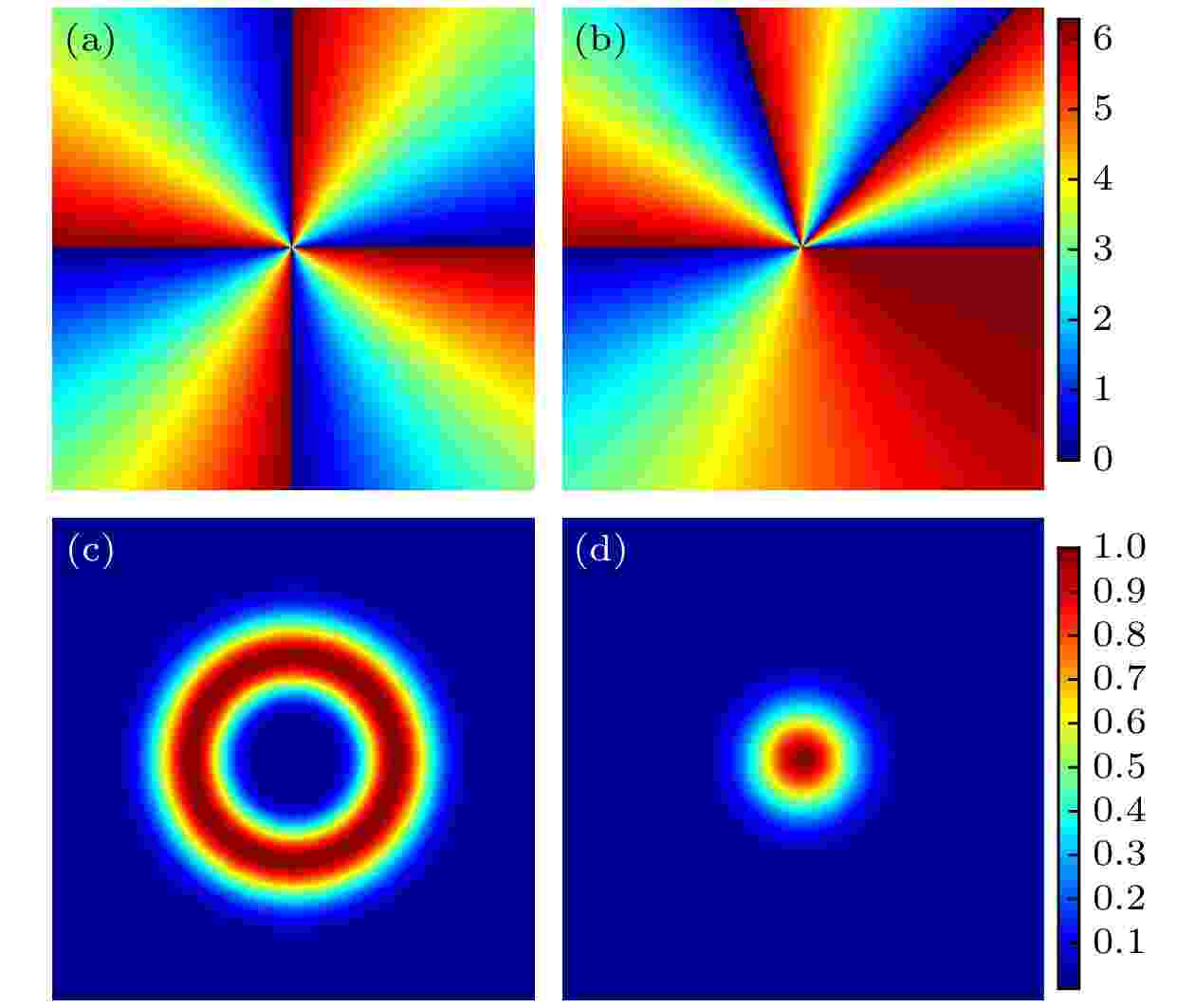
2022, 71 (1): 014203.
doi: 10.7498/aps.71.20211411
Abstract +
In this work, the propagation properties of partially coherent power-exponent-phase vortex beam are studied. Firstly, the propagation model of partially coherent power-exponent-phase vortex beam is established. Then, the propagation properties of partially coherent power-exponent-phase vortex beams in free space and ABCD optical system are simulated. The results show that when power-exponent-phase vortex beams propagate in free space, the topological charge, power order and coherence length have a great influence on the distribution of light intensity, and the area of light spot gradually increases with the increase of propagation distance. When the beam propagates in a focusing system, the changes of topological charge and power order will affect the light intensity distribution, while the coherence length has little effect on the overall intensity distribution of the beam, but only the quality of the spot. The research results of this work reveal the propagation properties of partially coherent power-exponent-phase vortex beam, which will lay a theoretical foundation for its applications in optical capture and other fields, and has important significance in promoting the theory and applications of new light field regulation.

2022, 71 (1): 014204.
doi: 10.7498/aps.71.20211514
Abstract +
The high-order Laguerre-Gaussian (LG) mode output from an end-pumped Nd:YVO4 laser cavity with strong spherical aberration (SA) induced by short-focal-length lens is studied in this work. A long-focal-length lens L1 is used in the cavity to expand and collimate the beam, so that the beam incident on another short-focal-length lens L2 in the cavity undergoes a strong SA. Since the ring-shaped LG modes with different values of angular index m have different beam radii, the actual focal points of each order of beam are then spatially displaced. A flat output coupler (OC) is located near the focal point of L2, which is composed of a cat-eye retroreflector together with the lens. Such a retroreflector can provide only ideal retroreflection to the incident beam with a focal point exactly on the OC. Given the focal point displacements of the LG beams with different orders, such a mechanism can be used for implementing the transverse mode selection. The mode which has an actual focal point on the OC has a smaller loss than the other defocused modes. With an a-cut Nd:YVO4 as laser crystal, scalar (linear-polarized) single-mode LG output with radical index p = 0 and angular index m>0 is obtained. The laser mode-order is selectable from LG0, ±10 to LG0, ±33 under 878.6-nm incident diode pump power of 1.03 W, by simply adjusting the distance between the OC and L2 in a range of 0.5 mm, when using lens L1 with f = 150 mm and lens L2 of f = 33.9 mm. It is found that sufficient SA which makes the optical paths of the neighboring modes well distinguishable is essential for single-mode operation of a wanted order of LG mode. However, too strong an SA can stop the high-order mode beam from oscillating, since the width and radius of the ring-shaped LG mode are an increasing function of indices p and m, which bring a stronger loss to the corresponding mode. Based on this analysis, we turn to a focal-length combination of f1 = 100 mm and f2 = 51.8 mm, to reduce the SA to a level suitable for further higher mode operation. A highest-order LG0, ±75 is obtained by such an SA mode-selecting technique under fixed pump power of 1.03 W.

2022, 71 (1): 014205.
doi: 10.7498/aps.71.20211417
Abstract +
A two-dimensional self-similarity transformation theory is established, and the focusing (parabolic) (2 + 1)-dimensional NLS equation is taken as the model. The two-dimensional self-similarity transformation is proposed for converting the focusing (2 + 1)-dimensional NLS equation into the focusing (1 + 1) dimensional NLS equations, and the excitation of its novel line-rogue waves is further investigated. It is found that the spatial coherent structures induced by the Akhmediev breathers (AB) and Kuznetsov-Ma solitons (KMS) also have the short-lived characteristics which are possessed by the line-rogue waves induced by the Peregrine solitons, and the other higher-order rogue waves and the multi-rogue waves of the (1 + 1) dimensional NLS equations. This is completely different from the evolution characteristics of spatially coherent structures induced by bright solitons (including multi-solitons and lump solutions), with their shapes and amplitudes kept unchanged. The diagram shows the evolution characteristics of all kinds of resulting line rogue waves. The new excitation mechanism of line rogue waves revealed contributes to the new understanding of the coherent structure of high-dimensional nonlinear wave models.

2022, 71 (1): 014206.
doi: 10.7498/aps.71.20200057
Abstract +
Free spectral range (FSR) of reflection spectrum of micro-ring resonator restricts the improvement in user capacity of the optical code division multiple access (OCDMA) system using micro-ring resonator array. Vernier effects can expand FSR of cascaded optical microring resonator. Based on vernier effect, a novel two-dimensional coherent optical en/decoder using serially coupled dumbbell micro-ring resonator is proposed in this paper. The theoretical model of optical transmission for series dumbbell-shaped microring resonators is established. The relation between the suppression of pseudo-modes in optical reflection spectrum and the coupling coefficient is analyzed in detail. The effects of coupling coefficient, processing error and chip rate on the performance of series dumbbell microring resonator optical en/decoder are studied. The en/decoding simulation experiments are carried out on a series dumbbell-shaped micro-ring resonator with radius of 40 μm-30 μm-40 μm respectively. The results show that comparing with the traditional series micro-ring resonator with radius of 40 μm-40 μm-40 μm respectively, the FSR value of dumbbell microcavity is increased by 4 times and the user capacity can increase exponentially. Meanwhile, the ratio of autocorrelation peak to maximum wing (P/W) and the cross-correlation ratio (P/C) are increased by about 33% and 8%, respectively.
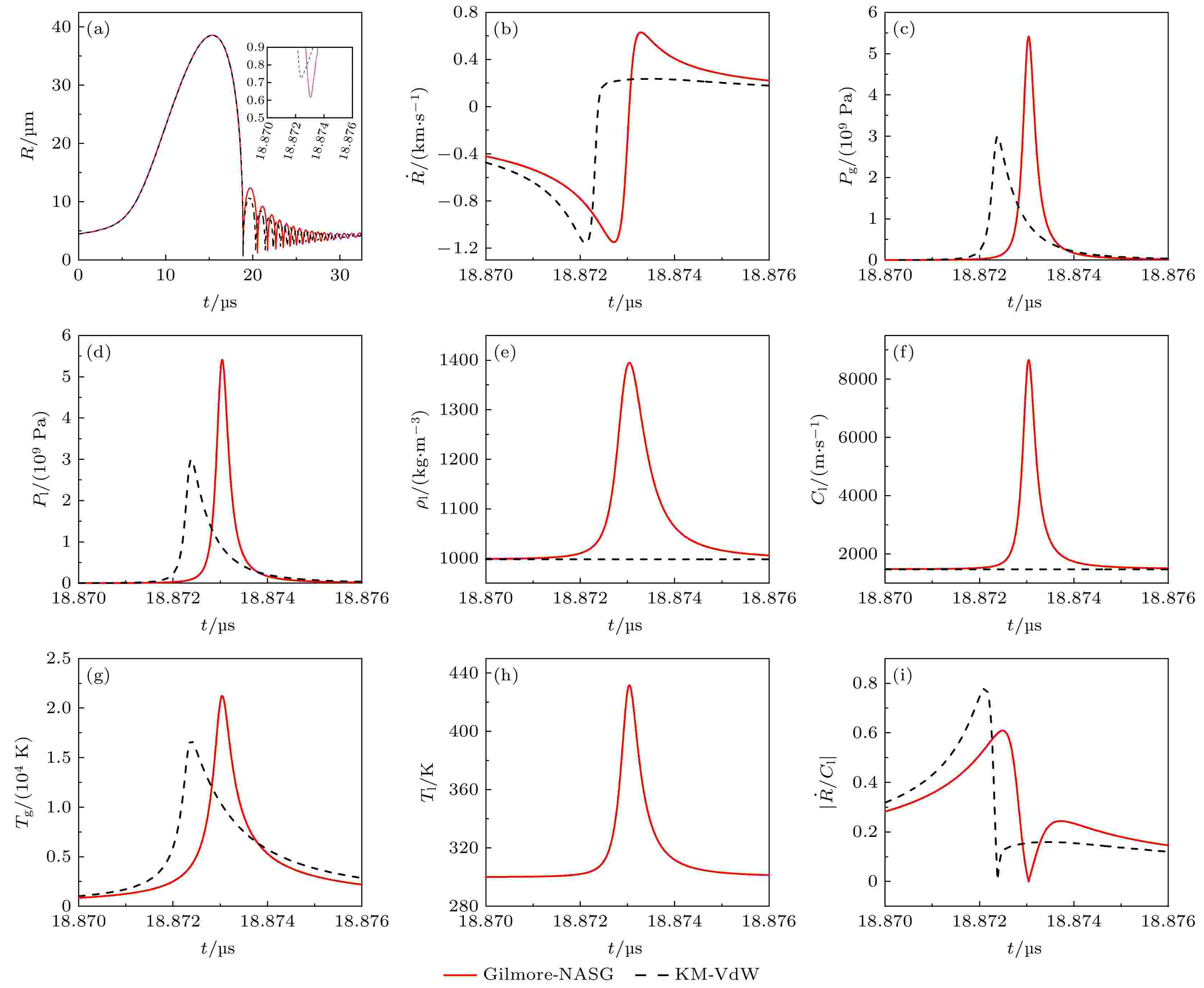
2022, 71 (1): 014301.
doi: 10.7498/aps.71.20211266
Abstract +
The newly proposed Gilmore-NASG model is used to study the acoustic cavitation characteristics of bubble in compressible liquid under the boundary condition of considering the compressible effect of the liquid, and comparison is made between the results calculated by the Gilmore-NASG model and original KM-VdW model without considering the mass exchange, chemical reaction and heat exchange between the gas in the bubble and the surrounding liquid. The results suggest that, compared with the KM-VdW model, the Gilmore-NASG model which employs a new equation of state to describe the gas, liquid and variations of liquid density and sound velocity due to compressibility, can give a larger compression ratio of cavitation bubble, a deeper collapse depth, higher temperature and pressure peaks. This is mainly because that the co-volume of argon molecule in the NASG equation of state is smaller than that in the VdW equation of state and the effect of the co-volume of water molecule is considered in the NASG equation of state, that is, the Gilmore-NASG model gives more comprehensive consideration to the liquid compressibility. When the bubble collapses violently, the Gilmore-NASG model takes into account the changes of sound velocity caused by the compressibility of the liquid at the bubble wall, effectively avoid the possibility of abnormal increase in the Mach number of the liquid at the bubble wall. With the increase in the driving sound pressure amplitude, the difference between the results given by the two models more and more significantly and the temperature and pressure peaks in the bubble given by the Gilmore-NASG model increase more significantly. With the rise of driving frequency, the difference between the results given by the two models gradually decreases and tends to be consistent under the high-frequency excitation. This indicates that the temperature and pressure in the bubble may arrive at higher values considering the compressibility of the medium caused by the co-volume changes of gas and surrounding liquid at different temperatures and pressures. In the meantime, the Gilmore-NASG model can accurately predict the changes in density, pressure and temperature of the liquid at the bubble wall as well as sound velocity, so this model has advantages in the study of bubble cavitation characteristics under high pressure and the effect of surrounding liquid on bubble cavitation characteristics. There will be important applications for the research on specific issues such as high-intensity focused ultrasound, shock wave lithotripsy treatment and sonochemistry.
PHYSICS OF GASES, PLASMAS, AND ELECTRIC DISCHARGES
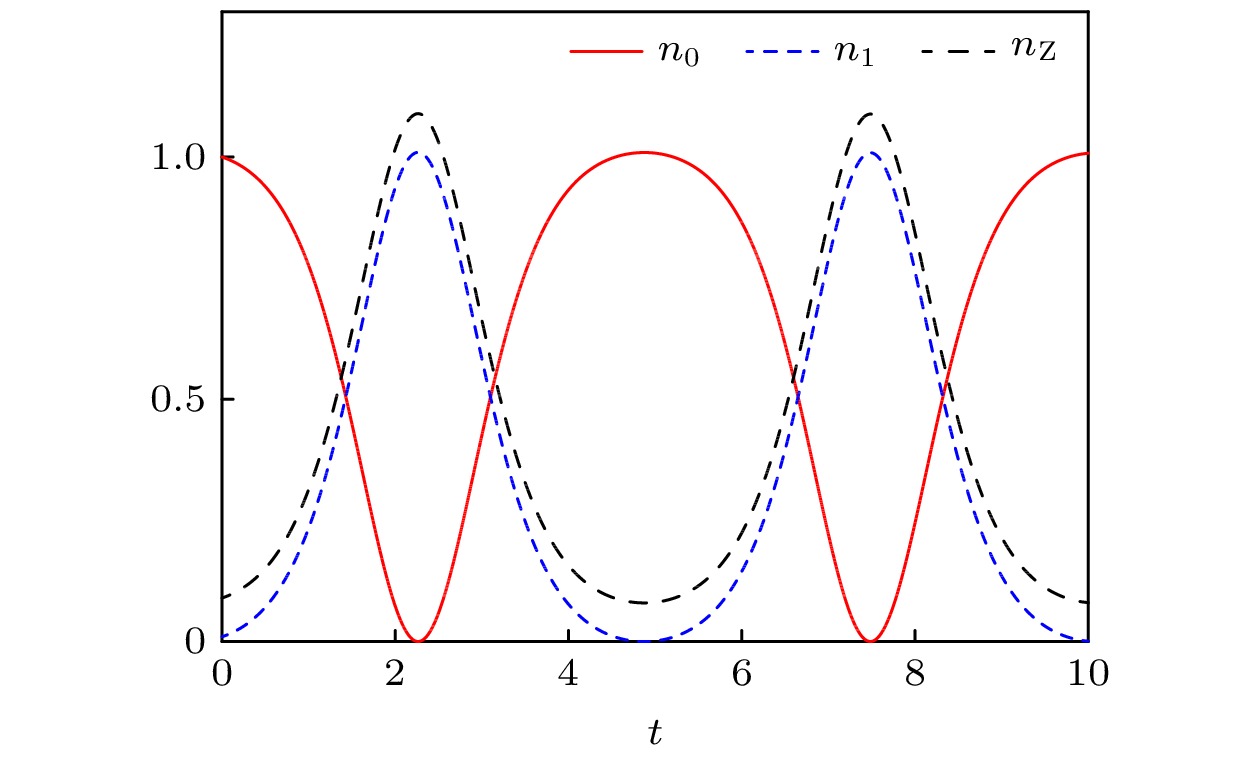
2022, 71 (1): 015201.
doi: 10.7498/aps.71.20211430
Abstract +
Based on the nonlinear three-wave interaction model including driving and dissipation, we construct a system to describe the nonlinear interaction between energetic particle induced geodesic acoustic mode (EGAM) and the drift waves turbulence in the Dimits shift region, and study both analytically and numerically the linear growth and nonlinear oscillation phases of the system, respectively. Further numerical results show that, without the contribution of EGAM, the system goes through limited cycle oscillation to period doubling, and finally route to chaos with the change of the linear drive/dissipation rate. On this basis, the nonlinear saturated “Dimits region” of the system is constructed, which is then used to study the influence of EGAM on the drift wave in the Dimits region. The results show that for EGAM with different amplitude and frequency, the modulated drift wave can be either excited or suppressed, partly reproduces the results from large scale simulation. Finally, We use the method of phase space analysis to give the corresponding explanation.
2022, 71 (1): 015202.
doi: 10.7498/aps.71.20211316
Abstract +
In order to achieve the optimal performance and reliability of the ion thruster in a wide power range, the influence of acceleration grid voltage and anode flow rate on the performance of ion thruster are studied experimentally and theoretically. The results show that in a certain range the ion beam current decreases continuously with the decrease of the absolute value of the accelerating voltage, and then increases suddenly. The electron backstreaming limited voltages in large and small thrust modes are –140 and –115 V, respectively. When the anode flow rate increases, the discharge voltage and discharge loss increase monotonically, and the deceleration current decreases monotonously. Under the power of 300−4850 W, the thrust is 11−188 mN, the specific impulse is 1800−3567 s, and the efficiency ranges from 34% to 67% by adjusting the anode current, grid voltage and working fluid gas flow. The maximum efficiency of thruster reaches 67% at 3000 W. This turning point is critical for thruster design and on-orbit applications. Choosing a reasonable range of working parameters can improve the performance and life of the thruster in application.
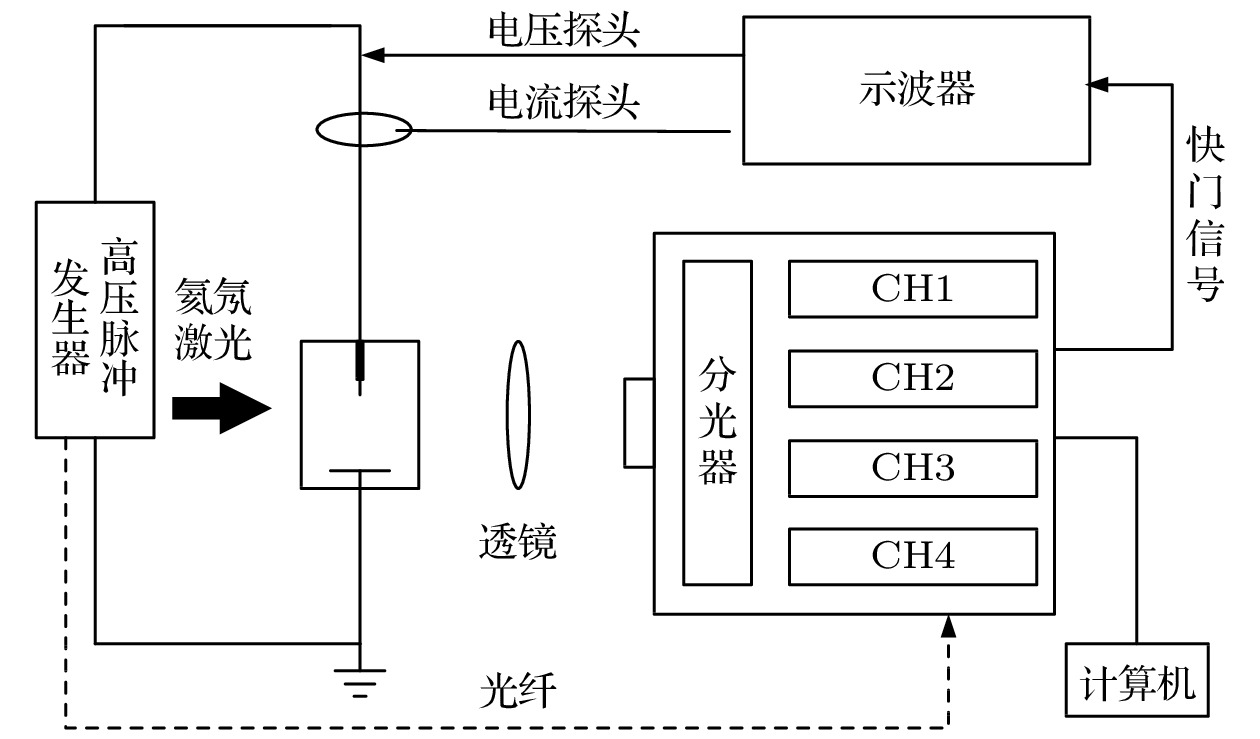
2022, 71 (1): 015203.
doi: 10.7498/aps.71.20211162
Abstract +
The streamer discharge in water is a main object for studying the basic physical and chemical processes of an electric discharge in water. In this paper, the re-illuminations and the pause behaviors of a streamer filament of the microsecond pulsed streamer discharge in water with different conductivities (20 to 800 µS/cm) are studied by adopting a needle-plate electrode system and an ultra-high-speed camera system. The cause why the re-illumination of the streamer filament is difficult to detect by using the camera system as the water conductivity gets higher is discussed. It is found that the re-illumination alternately occurs among different streamer filaments, and two modes of the re-illumination are identified: one is that the whole filament quenches and then illuminates again; the other is that only the tip part of the filament quenches and then resumes the illumination. The appearance rate of the re-illumination of the streamer filament decreases rapidly as the water conductivity increases, and then drops to zero as the water conductivity exceeds 540 µS/cm. Within a water conductivity range of 20–800 µS/cm, the appearance rate of segmentation in shockwave pattern of the streamer filament is larger than 65%, indicating that the pause is a common behavior of the streamer filament. By measuring the difference in radius between two adjacent shockwave segments, the average pause period of the streamer filament is estimated at 157 ns, which is almost not affected by the water conductivity. As the water conductivity increases, the light intensity of the streamer filament increases rapidly. The light intensity of the streamer filament cannot decay to the noise level of the camera system during the pause period of the streamer filament as the water conductivity exceeds 350 µS/cm. The streamer filament produces glow on the light emission image, which makes it difficult to distinguish the “extinction and illumination” process by the camera system.
CONDENSED MATTER: STRUCTURAL, MECHANICAL, AND THERMALPROPERTIES

2022, 71 (1): 016101.
doi: 10.7498/aps.71.20211415
Abstract +
The nucleation mechanism of Ti3Al alloy is simulated by the molecular dynamics method in this work. The atomic clusters on different spatial scales are identified in the solidification process by the cluster-type index method (CTIM), and the formation process and the growth process of critical nucleus are studied in depth. It is found that the solidification system contains ten thousands of different types of atomic cluster structures, but only 22 types play a key role in the nucleation process. In the nucleation and growth process of nuclei, the ICO-like cluster, the BCC-like cluster, and the defective FCC cluster and the defective HCP cluster respectively reach their saturation points at the characteristic temperature T1 (1110 K), T2 (1085 K) and T3 (1010 K). And the competition processes of these clusters are revealed according to the changes of their number and spatial distribution with temperature. By tracing the nucleation and growth process of the grain with parallel twin, it is found that the critical crystal nucleus is composed of single-phase FCC structures, and the preferent nucleation of metastable bcc structure is not observed. The twinned structure is formed by the layer-by-layer growth along the close-packed plane. It is also found that the CTIM is more accurate than other methods in revealing the microstructural characteristics during the solidification.
CONDENSED MATTER: STRUCTURAL, MECHANICAL, AND THERMAL PROPERTIES
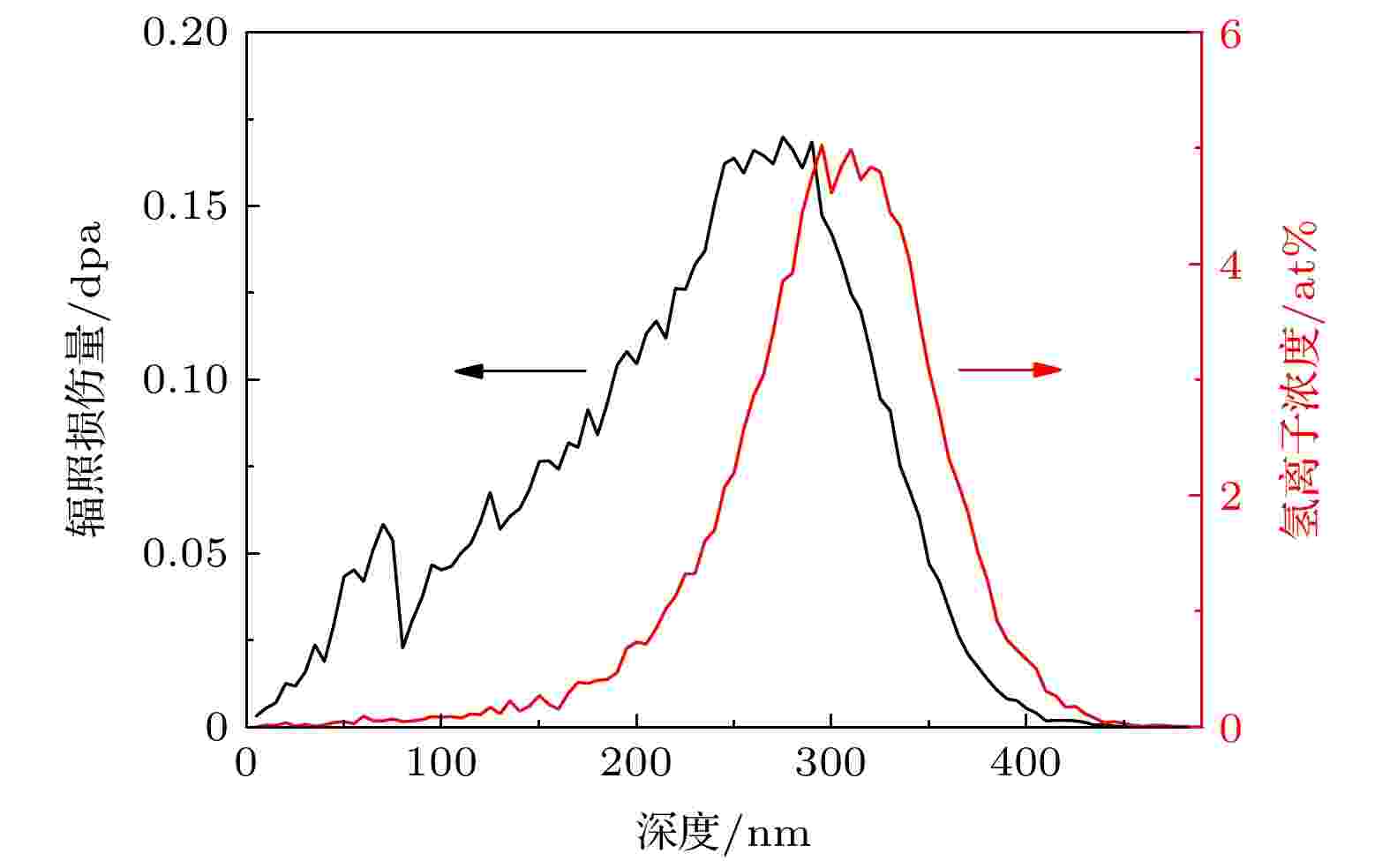
EDITOR'S SUGGESTION
2022, 71 (1): 016102.
doi: 10.7498/aps.71.20211229
Abstract +
The one-dimensional (1D) glide motion of dislocation loops along the direction of Burgers vector in various metallic materials has attracted considerable attention in recent years. During the operation of nuclear fusion reactor, component materials will be bombarded by high energy neutrons, resulting in production of radiation defects such as self-interstitial-atoms (SIAs), vacancies and their clusters. These defects feature large difference in migration energy, which may lead to concentration imbalance between SIAs and vacancies, and eventually irradiation damages such as swelling and embrittlement. Generally speaking, the mobility of a defect cluster is lower than that of a point defect. However, fast 1D motion may also take place among SIA clusters in the form of prismatic dislocation loops. This increases the transport efficiency of SIAs towards grain boundaries, surface and interface sites in the material, in favour of defect concentration imbalance and damage accumulation. To date, most literature works have found that the 1D motion of dislocation loops exhibited short-range (nanometer-scale) character. In addition, such experimental studies were generally conducted in pure metals using high voltage electron microscopes (HVEM) operated at acceleration voltages ≥1000 kV. However, for pure aluminum (Al), the maximum transferable kinetic energy from 200 keV electrons is 19.5 eV, while the displacement threshold energy is only 16 eV. Therefore, the observation and mechanistic investigation of 1D motion of dislocation loops in Al should also be possible with conventional transmission electron microscopes (C-TEM), as it may also exhibit the effects of beam heating and point defect production in HVEM. In view of the shortage of HVEM, this work reports the 1D motion of dislocation loops in pure Al implanted with hydrogen ions using C-TEM. Simultaneous dislocation loop motion in opposite directions of Burgers vector 1/2$\left\langle {110} \right\rangle $ has been captured, as well as the collective 1D motion of an array of dislocation loops in the direction of Burgers vector 1/3$\left\langle {111} \right\rangle $ under 200 keV electron irradiation. In addition, 1D motion of dislocation loops up to micron-scale range along the direction of Burgers vector 1/3$\left\langle {111} \right\rangle $ , and up to a few hundred nanometers range along the direction of Burgers vector 1/2$\left\langle {110} \right\rangle $ have been found, which is different from previous literature works. A characteristic migration track would form behind the moving dislocation loop, lasting for about tens of seconds. The more rapid the dislocation loop motion, the longer the migration track length is. The concentration gradient of SIAs by electron irradiation and the redistribution of hydrogen atoms caused by the moving dislocation loops may account for the observed micron-scale 1D motion of dislocation loops and the migration tracks.
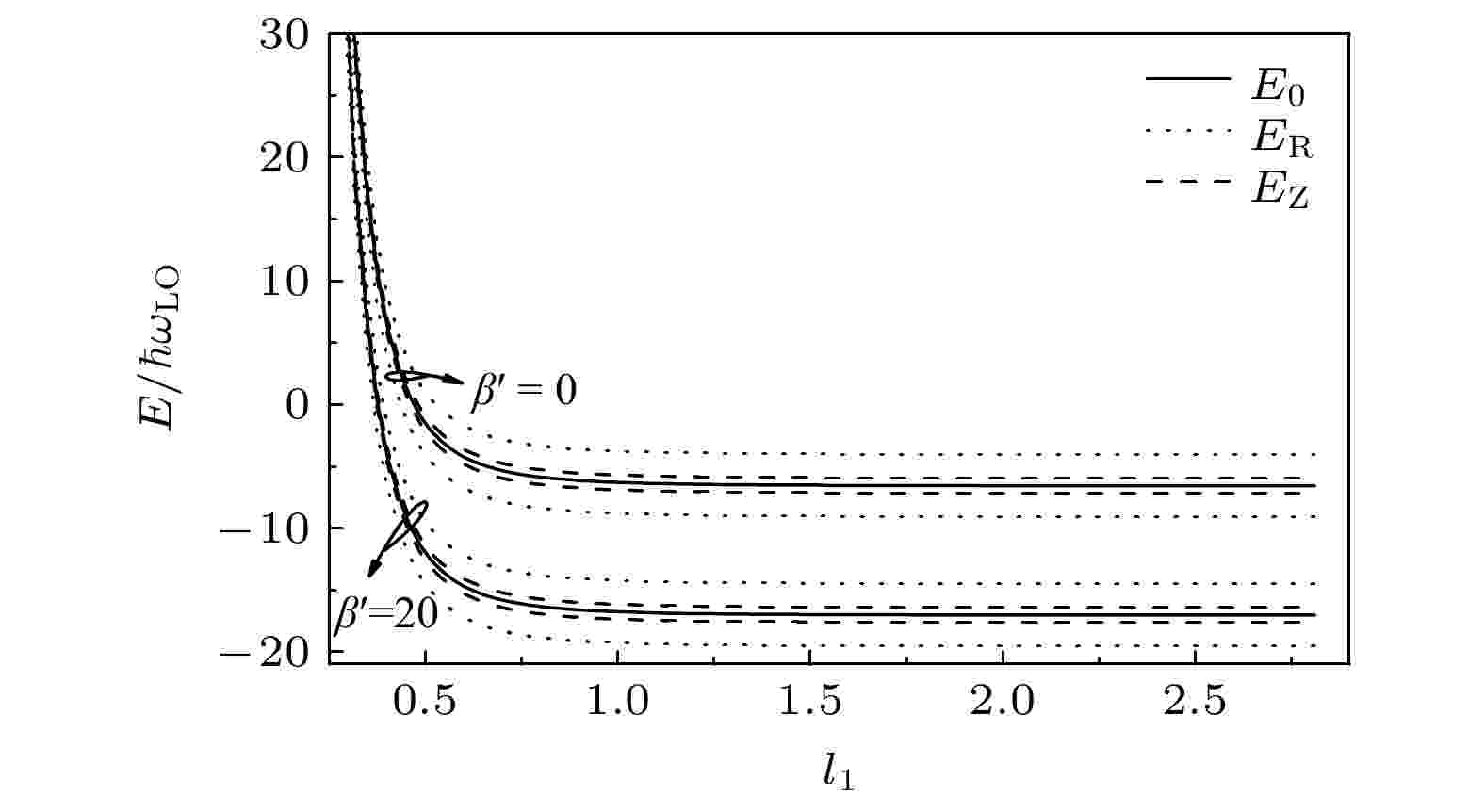
2022, 71 (1): 016301.
doi: 10.7498/aps.71.20210803
Abstract +
The influence of Rashba effect and Zeeman effect on the properties of bound magnetopolaron in an anisotropic quantum dot are studied with Pekar variational method. The expression of the ground state energy of the bound magnetopolaron is obtained through theoretical derivation. The relationship of the ground state energy of the polaron with the transverse effective confinement length, the longitudinal effective confinement length, the magnetic field cyclotron resonance frequency, and the Coulomb bound potential are discussed, respectively. Owing to the crystal structural inversion asymmetry and the time inversion asymmetry, the polaron energy experiences Rashba spin-orbit splitting and Zeeman splitting. Under the strong and weak magnetic field, we discuss the dominant position of Zeeman effect and Rashba effect, respectively. Owing to the presence of phonons and impurities, the polaron is more stable than the bare electron state.
CONDENSED MATTER: ELECTRONIC STRUCTURE, ELECTRICAL, MAGNETIC, AND OPTICAL PROPERTIES
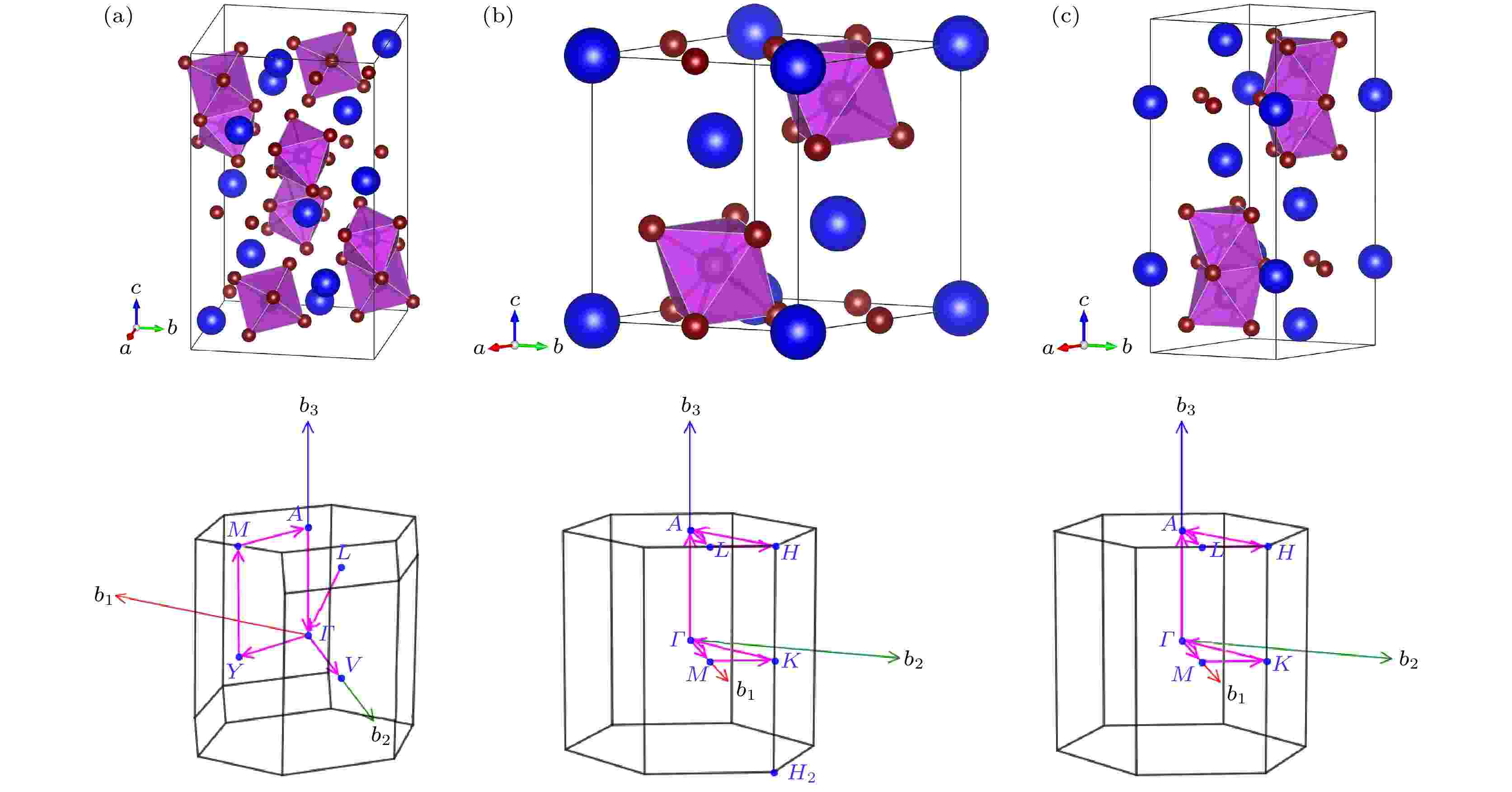
2022, 71 (1): 017101.
doi: 10.7498/aps.71.20211599
Abstract +
Organic-inorganic halide perovskite materials are widely used in solar cells because of their excellent photoelectric properties. However, the stability and lead toxicity problems associated with materials and devices have restrict their production and development. Compared with the hybrid perovskite, the inorganic lead-free perovskite Cs3Bi2I9 has attracted wide attention because of its stronger stability and environmental friendliness. The Cs3Bi2I9 has three crystal types: monoclinic type, trigonal type, and hexagonal type. At present, the researches of Cs3Bi2I9 focus mainly on the hexagonal phase. In this paper, based on the first principles of density functional theory, the electronic properties, carrier effective mass values, stabilities, and optical properties of Cs3Bi2I9 monoclinic, trigonal, and hexagonal phases are studied theoretically. It is suggested that the stabilities of the three crystal phases are similar, and the direct band gap (1.21 eV) of the trigonal phase would be noticeable. For the three phases, their effective mass values show that their properties are the same along both the a direction and the b direction, but different along the c direction. The effective mass of electron of the trigonal phase is significantly smaller along the a-direction than along the c-direction. Corresponding to the red shift phenomenon of optical properties, the trigonal phase shows the better optical absorption performance than other phases. In addition, the optical properties also show that the properties are the same along the a direction and the b direction, but different along the c direction, and the optical absorption performance is better along the a-direction than along the c-direction.
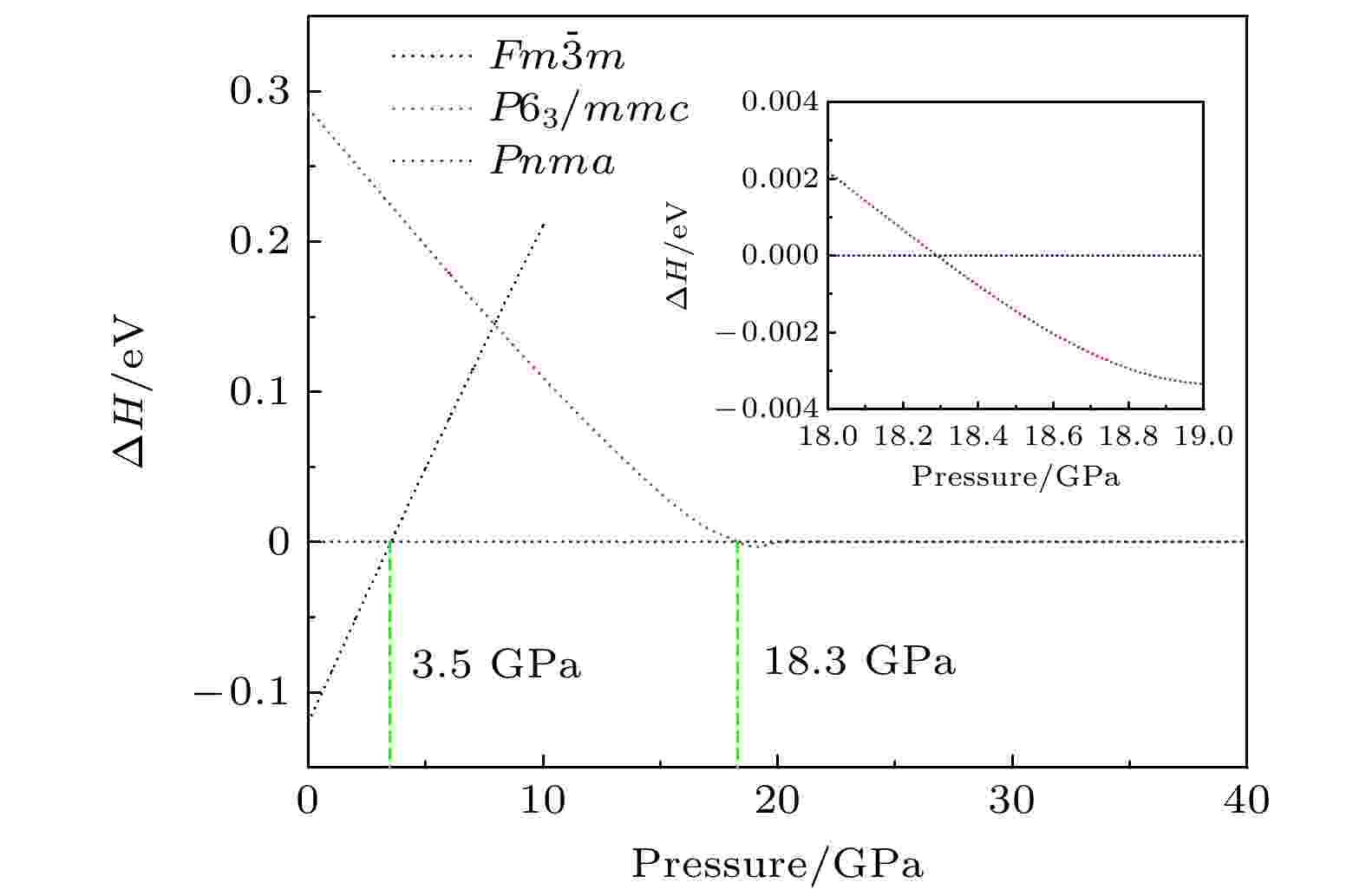
2022, 71 (1): 017102.
doi: 10.7498/aps.71.20211163
Abstract +
There have been some theoretical studies of high pressure phase transition behavior of BaF 2, while in most cases the attention is paid mainly to the optical and electrical properties of BaF 2 under increasing pressure. To date, there has been still a lack of theoretical explanation for the hysteresis phenomenon of high-pressure phase of BaF 2 when the pressure is released. In addition, the pressure-dependent behavior of the BaF 2 band gap is still under controversy, and there are few studies of its high-pressure Raman spectra. Therefore, first principle is used to make a supplementary calculation of the high pressure behavior of BaF 2. For a given pressure P and temperature T, the thermodynamic stable phase has the lowest Gibbs free energy. The calculations are performed at zero temperature and hence, the Gibbs free energy becomes equal to the enthalpy. Thus, the variation of enthalpy is calculated as a function of pressure to study the high-pressure phase stability of BaF 2 based on density functional theory as implemented in the Vienna ab initio simulation package (VASP). The results show that the BaF 2 undergoes two structural phase transitions from Fm3 m(cubic) to Pnma (orthorhombic) and then to P6 3/ mmc(hexagonal) with increasing pressure, and their corresponding transition pressures are 3.5 and 18.3 GPa, respectively. By calculating the evolution of lattice constant with pressure, it is found that at about 15 GPa (near the second phase transition pressure), the lattice constants of the Pnma structure show abnormal behavior (a slight increase in b o and a slight decrease in a o). We suggest that this behavior leads the band gap to decrease, indicated by analyzing the calculated results of Pnma structure of other materials. The Pnma structure completely transforms into P6 3/ mmc structure at about 20 GPa. By analyzing the phonon dispersion curves of BaF 2 as a function of pressure, the structural stability information of the material can also be obtained. Then the density functional perturbation theory (DFPT) is used to calculate the phonon dispersion curves of BaF 2 by VASP code and Phonopy code. The hysteresis phenomenon of the P6 3/ mmc structure, when the pressure is released, is explained by the kinetic stability. The results predict that the P6 3/ mmc structure can be stabilized at least to 80 GPa.
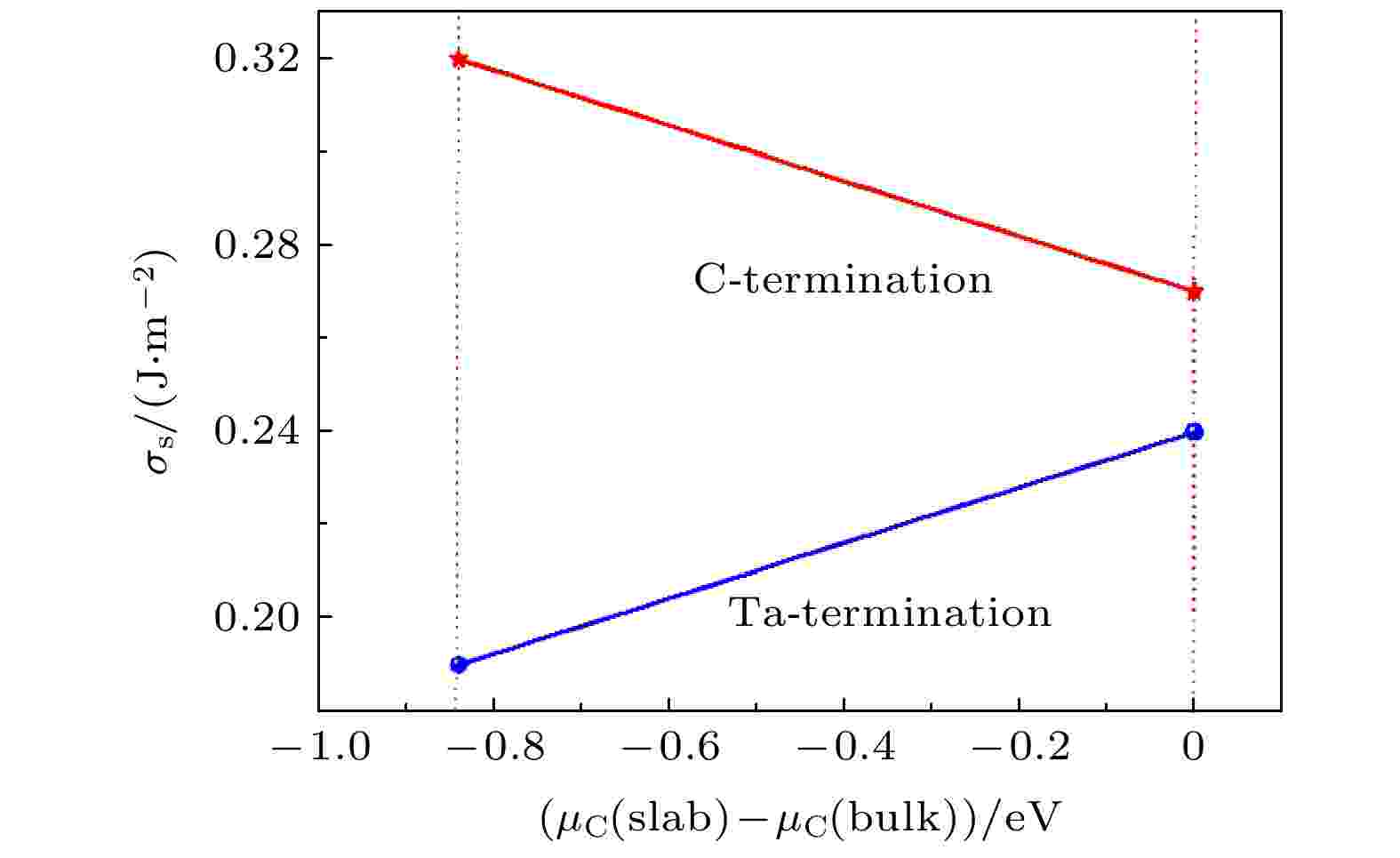
2022, 71 (1): 017103.
doi: 10.7498/aps.71.20210400
Abstract +
The adsorption and desorption behaviors of ammonia on TaC(0001) surface are studied by employing spin-polarized density function theory calculations. The surface energy calculation results show that the TaC (0001) terminating with Ta is the most stable surface. According to the optimized structural and energetic properties, it is found that NH3 prefers to adsorb on the top site, whereas NH2, H prefer to adsorb on the triple hcp site and NH, N prefer to stay on the triple fcc site. In addition, three transition states are found for analyzing the mechanism of dehydrogenation of NH3, and the N recombination reaction is also considered. The results show that the desorption of nitrogen atoms is the rate-determining step in the overall reaction. Finally, in order to further elucidate the mechanism of NH3 adsorption and dissociation on the surface of Ta-TaC, the electronic structure of the most stable adsorption position is analyzed from the perspective of charge density distribution and electron density of states. The results of electronic structure calculation show that NH3 molecule is adsorbed on the surface through the mixture of 2pz orbital of N atom and $ 5{\rm d}_{z^2} $ orbital of substrate Ta. With the progress of dehydrogenation, the charge transfer phenomenon becomes more and more serious. The charge transfer between adsorbate and substrate plays an important role in accelerating NH3 dehydrogenation catalytic process.
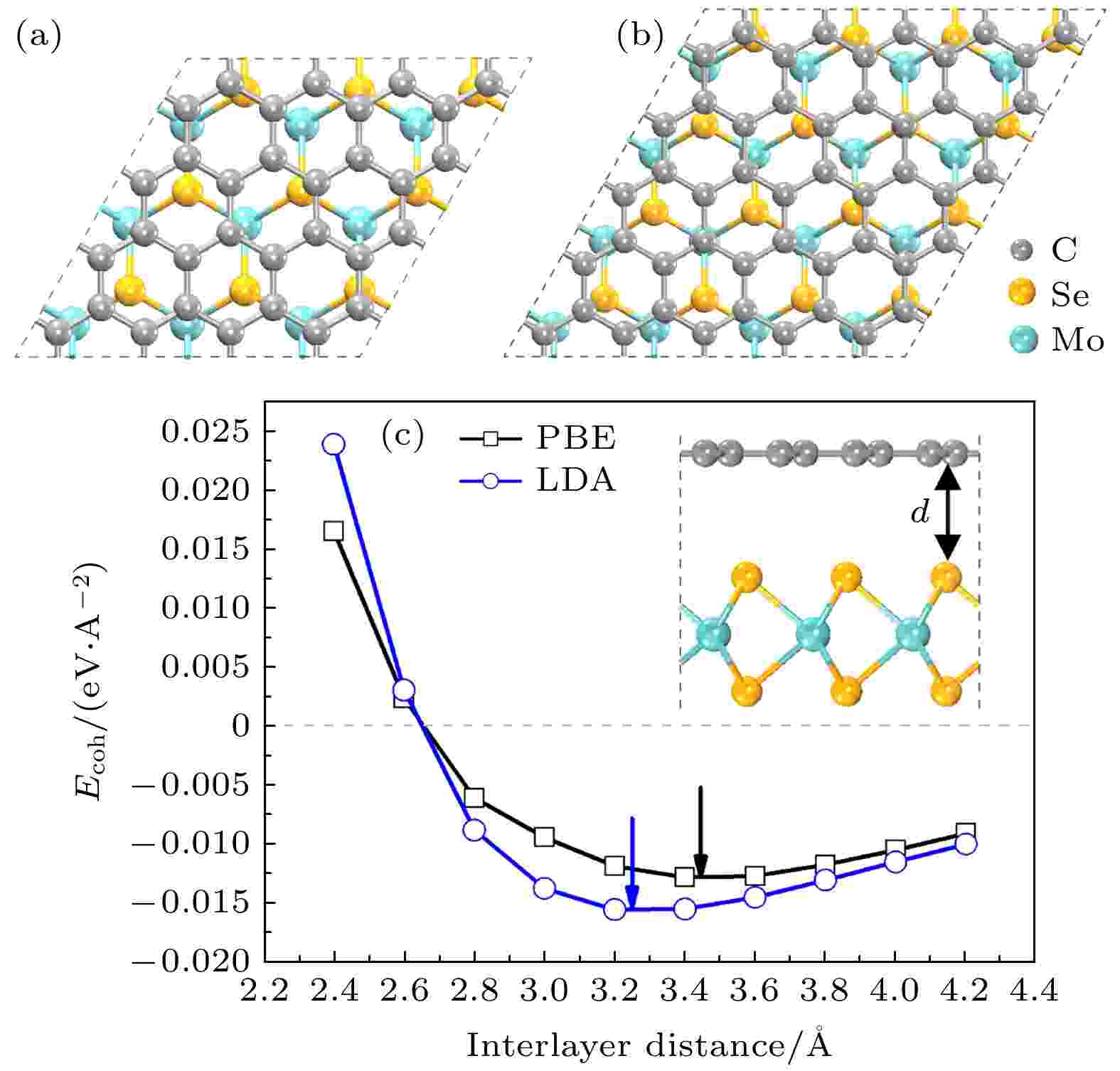
2022, 71 (1): 017104.
doi: 10.7498/aps.71.20210238
Abstract +
Although graphene-based heterostructures exhibit excellent intrinsic properties for device scaling, fabricating low Schottky barrier is still a great challenge to the electrical transport behaviors of nanoelectronic devices. Exploring excellent materials for electronic devices are a research hotspot at present. Graphene not only exhibits excellent physical strength and specific surface area, but also presents high carrier mobility and thermal conductivity. Therefore, graphene has been developed in many fields such as energy, catalysis, etc. However, graphene is a special material with zero band gap, and its electrons and holes are easy to compound, which seriously hinders its development in the applications of electronic and optoelectronic devices. Two-dimensional transition metal dichalcogenides (TMDs) have the advantages of controllable band gap properties, which makes them have a good development in logic circuits and photodetectors. As one of TMDS, MoSe2 possesses the advantages of narrower band gap, better electron hole separation and stronger oxidation resistance in the environment. Therefore, the design of graphene and MoSe2 heterostructures is an ideal choice for a new generation of nanoelectronic devices. Here, we investigate systematically the effects of asymmetric O doping on the electronic properties and Schottky barrier of graphene/MoSe2(1–x)O2x heterostructure for the first time by first-principles calculations incorporating semiempirical dispersion-correction scheme. The results indicate that graphene and MoSe2 monolayer can form a stable van der Waals heterostructure with preserving their own intrinsic properties. In addition, an n-type schottky contact with a barrier height of 0.558 eV is obtained. Further, it is found that the type and the height of the Schottky barrier can be controlled by changing the concentration and sites of the O dopant at interface. By increasing the concentration of the O dopant inside the interface, the transition from an n-type Schottky contact to an Ohmic contact can be realized, and a low n-type Schottky barrier is gained with increasing the concentration of the O dopant outside the interface for highly efficient charge transfer. The barrier height of heterostructure decreases from 0.558 eV to 0.112 eV when the O dopant is doped on the outer interface. Finally, as a complement to previous results, it is confirmed that the redistribution of interfacial charges leads the Fermi level to shift, and thus determining the type and the height of Schottky barrier. This study may provide theoretical guidance for designing and manufacturing the MoSe2-based nano field effect transistors.

2022, 71 (1): 017105.
doi: 10.7498/aps.71.20211317
Abstract +
Two-dimensional magnetic material which has been rapidly developed in recent years, has potential applications in developing spintronic devices. In order to understand the magnetic properties of two-dimensional magnetic materials, it is necessary to comprehend the magnetic interaction which is estimated by the exchange parameters between the magnetic atoms. The calculation of the magnetic exchange parameters is based on the first-principle. The commonly used method of determining the values of exchange parameters is energy-mapping. However, this method has some disadvantages. In this paper, the spin-spiral dispersion relationship is derived under the Heisenberg interaction and the Dzyaloshinskii-Moriya (DM) interaction through the generalized Bloch condition of three common two-dimensional magnetic structures: a tetragonal structure, a hexagonal structure in which the cell contains one magnetic atom, a hexagonal structure in which the cell contains two magnetic atoms. The magnetic exchange parameters of some materials are calculated through the first principle. These materials are MnB, VSe 2 MnSTe and Cr 2I 3Cl 3. Among them, the MnSTe and Cr 2I 3Cl 3 are two-dimensional Janus materials, which means that they have space-reversal symmetry broken, that is why there is DM interaction in the system.
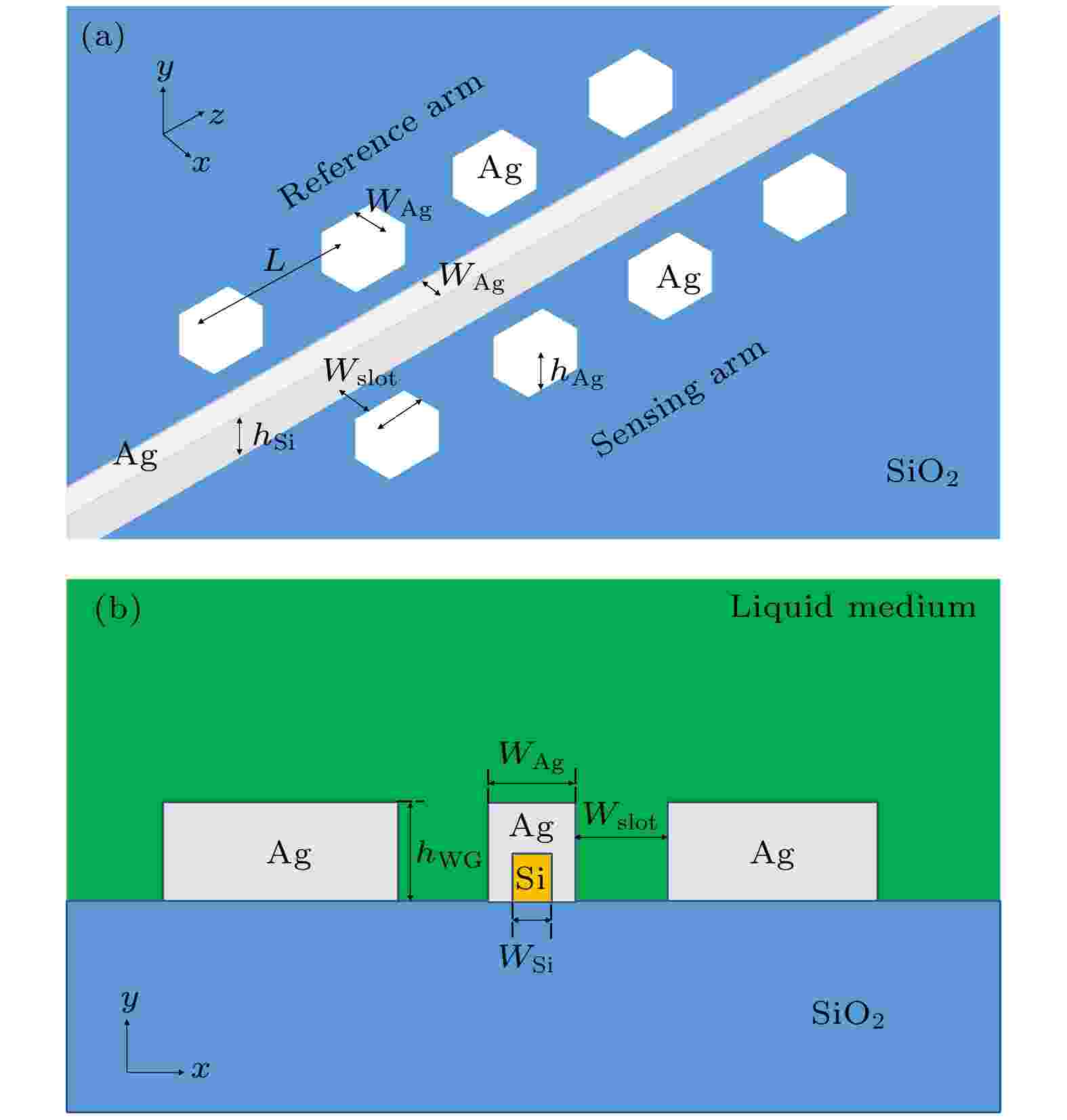
2022, 71 (1): 017301.
doi: 10.7498/aps.71.20211420
Abstract +
In this paper, a Mach-Zehnder interferometric sensing structure based on silver nanochains of surface plasmons is optimized. The structure consists of a reference arm, a sensing arm and a nanowire waveguide. Nanowire waveguides are composed of silicon nanowires wrapped with a certain thickness of silver. Introduce two silver nanochains as the reference arm and the sensing arm of the Mach-Zehnder interferometer. And research the transmission characteristics of the designed structure. Improve the accuracy and sensitivity of the designed structure by reducing the transmission loss. Compared with two identical silver nanowires as the reference arm and the sensing arm. After the reference arm and the sensing arm are changed to silver nanochains, the transmission characteristics are significantly improved, and the loss per unit length is obviously reduced. This is because the long-range or coulomb interaction between the unit structures of the silver nano-chains enhances the electromagnetic field in the structure, thereby reducing the transmission loss. We set the lattice constants of the two silver nanochains to different situations. The study found that under the wider width of silicon-coated silver nanowires and certain duty ratios. The unit transmission loss of a structure containing asymmetric silver nanochains is smaller than that of a structure containing symmetric silver nanochains. It can be known that silver nanoparticle chains with small loss can compensate for the transmission loss of silver nanoparticle chains with large loss. Using this feature, we further optimized the design structure and changed one side of the silver nano-chain to nano-wire. Change the lattice constant and duty cycle of the silver nanochain on the other side. We have found that in most cases, this type of structure has better transmission characteristics than a structure containing two silver nanochains and a structure containing two silver nanowires. Our design structure can greatly reduce the transmission loss of the traditional Mach-Zehnder interferometer. Moreover, the fault tolerance rate is high in the preparation process of the structure. It has huge potential application value in practical application.
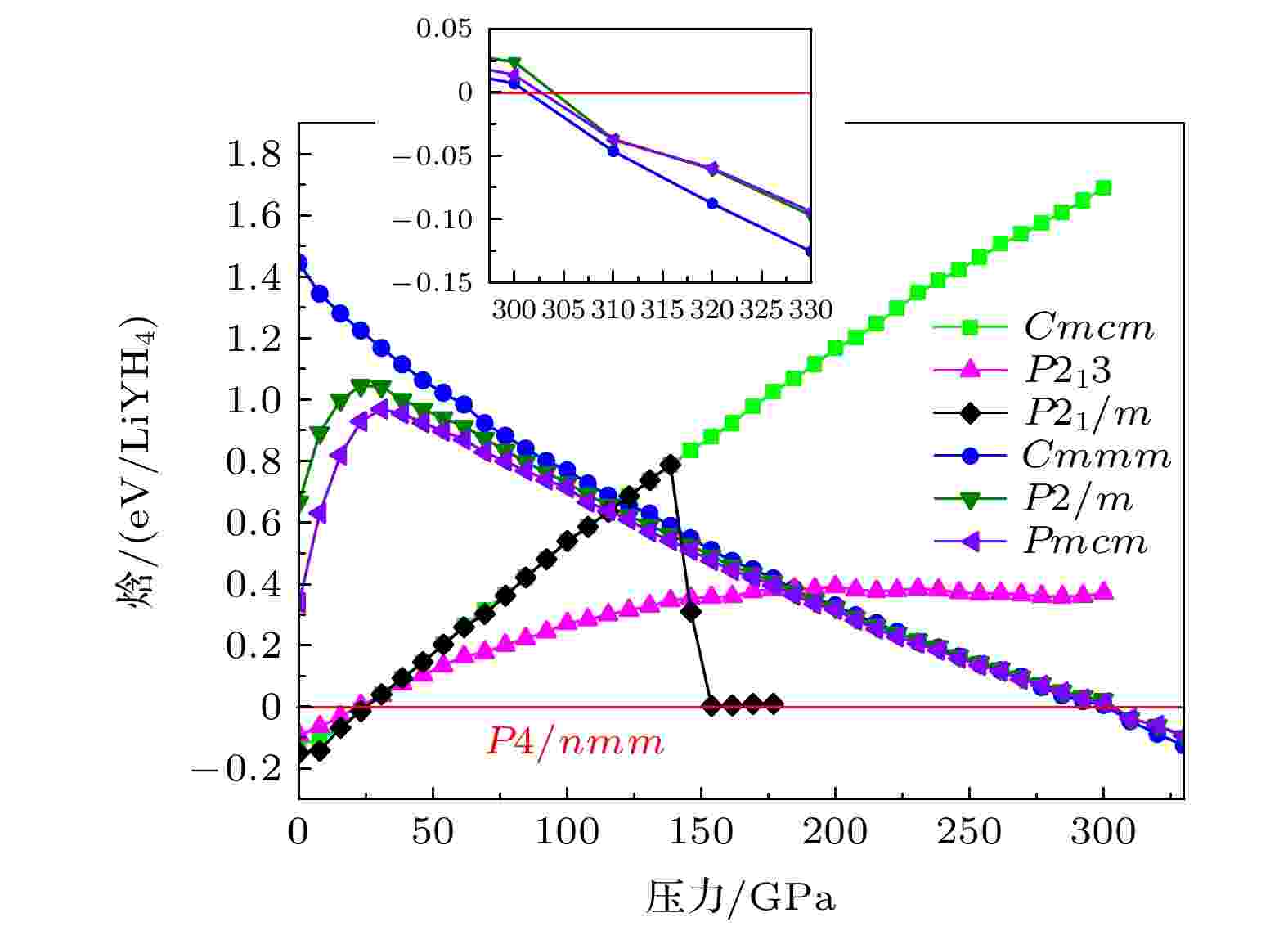
2022, 71 (1): 017401.
doi: 10.7498/aps.71.20210824
Abstract +
The research on the superconductivity of hydrogen-rich compounds has become a hot research topic in the field of high-temperature superconductors in recent years and yttrium hydride YH9+x has been experimentally confirmed to have high temperature superconductivity (near room temperature (Tc = 262 K)), following behind the research of H3S (Tc = 200 K) and LaH10 (Tc = 260 K). The theoretical study of binary hydrogen-rich systems is relatively mature, while the structural characteristics and superconductivity of ternary or quaternary hydrogen-rich compounds are still under exploration. In this paper, nLiH + YH3→LinYHn+3 (n = 1–3) is the synthesis way to explore the stable configuration of ternary hydride LinYHn+3 in a pressure range of 0–300 GPa. The crystal structure, electronic structure, thermodynamic and kinetic stability of LiYH4, Li2YH5 and Li3YH6 in the pressure range of 0–300 GPa are studied based on the structure prediction by particle swarm optimization algorithm and first-principles calculation. The CALYPSO method is used to search for 1–4 times molecular formula structures for Li-Y-H ternary systems with different stoichiometric ratios in the pressure range of 0–300 GPa in steps of 50 GPa. The results show that LiYH4-P4/nmm, Li2YH5-I4/mmm, and Li3YH6-P4/nmm can be respectively synthesized with a certain ratio between LiH and YH3 respectively in a pressure range of 169–221 GPa, 141–300 GPa and 166–300 GPa. The Li2YH5 has the lowest stable pressure and widest range which can be the possible choice in experiment. The results can provide the data support for the superconductivity research and experimental synthesis of hydrides in Li-Y-H ternary system.
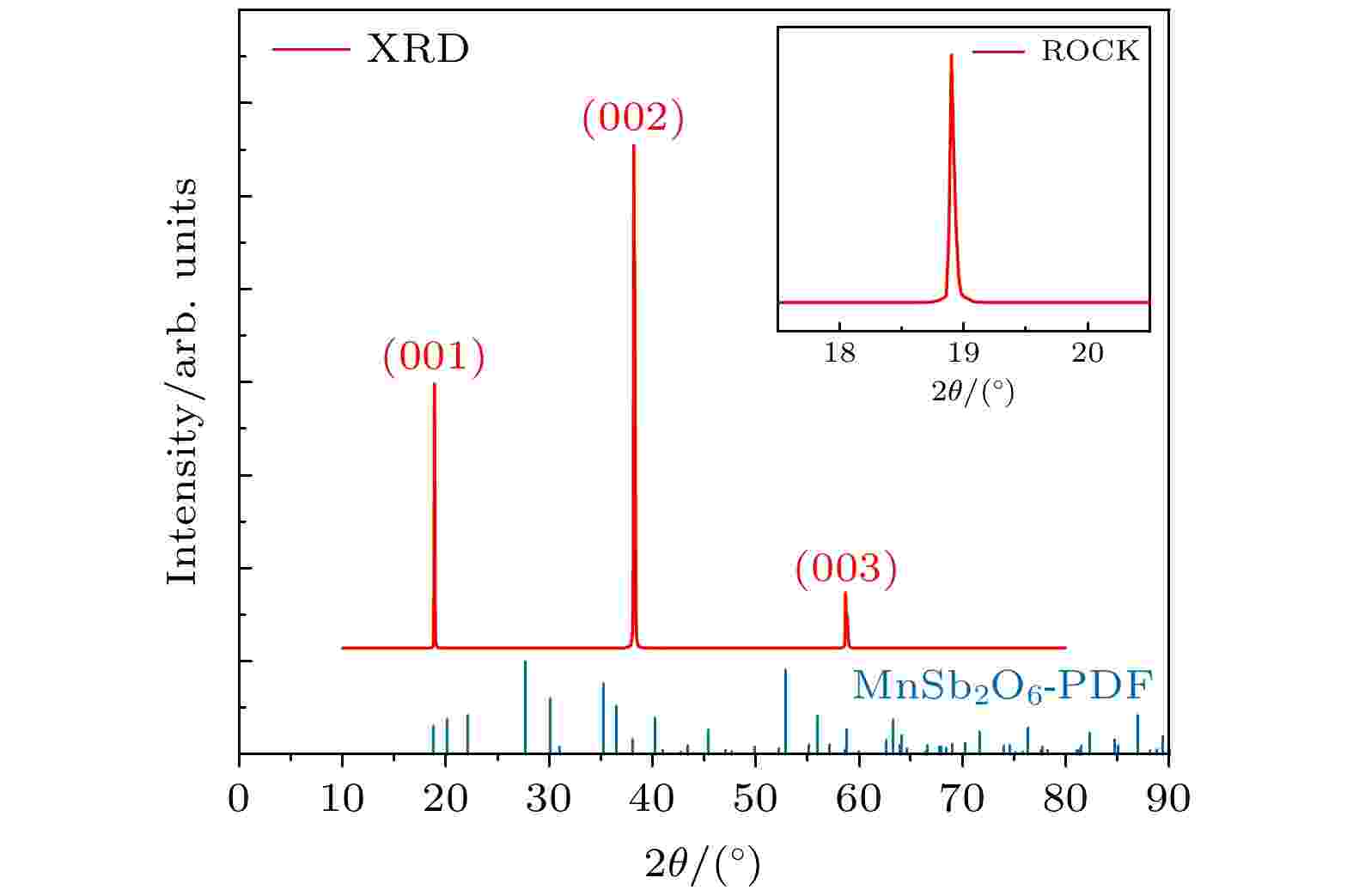
2022, 71 (1): 017501.
doi: 10.7498/aps.71.20211465
Abstract +
The magnetic materials with a chiral crystallographic lattice have hold neither inversion center nor mirror plane, leading to the emergence of Dzyaloshinskii-Moriya interaction and exotic physical phenomena like skyrmion, multiferroicity, and chiral solition lattice. The trigonal oxide MnSb2O6 is recognized as a novel chiral-lattice helimagnet with unusual multiferroic properties, where magnetic field enables the selecting of a single ferroelectric domain and a slight tilting of field direction can trigger the reversal of electric polarization. Single crystal of MnSb2O6 is prepared by the flux method. The magnetic susceptibility at 2 K shows a linear field dependent behavior except in the low field region. The magnetization shows a deviation from linearity at around 0.2 T for H⊥c, while a step-like anomaly is observed at about 1 T for H//c, suggesting the domain selection and spin-flop transition, respectively. The electron spin resonance parameters, such as the resonance field, the g-factor and the linewidth ΔH, are obtained by performing single Lorentzian line. Interestingly, the resonance field shows a distinct, anisotropic temperature dependent behavior when further cooling, the resonance field shifts towards the lower field direction for H⊥c, while it shifts towards higher field direction for H//c. Excluding several mechanisms for this FM-like temperature dependent behavior of the resonance field, combining the ground state of spiral phase and its unique multiferroic properties, we suggest that the spiral magnetic structure of the ground state of MnSb2O6 forms a conical magnetic structure under external magnetic field. Based on this, we can speculate the variation of ferroelectric polarization intensity with moderate and higher magnetic field. Moreover, the critical fitting of the ESR linewidth gives an unusual small critical index, p = 0.49 for H⊥c and p = 0.54 for H//c, implying that the magnetism possesses a two-dimensional characteristic and competitive interaction.
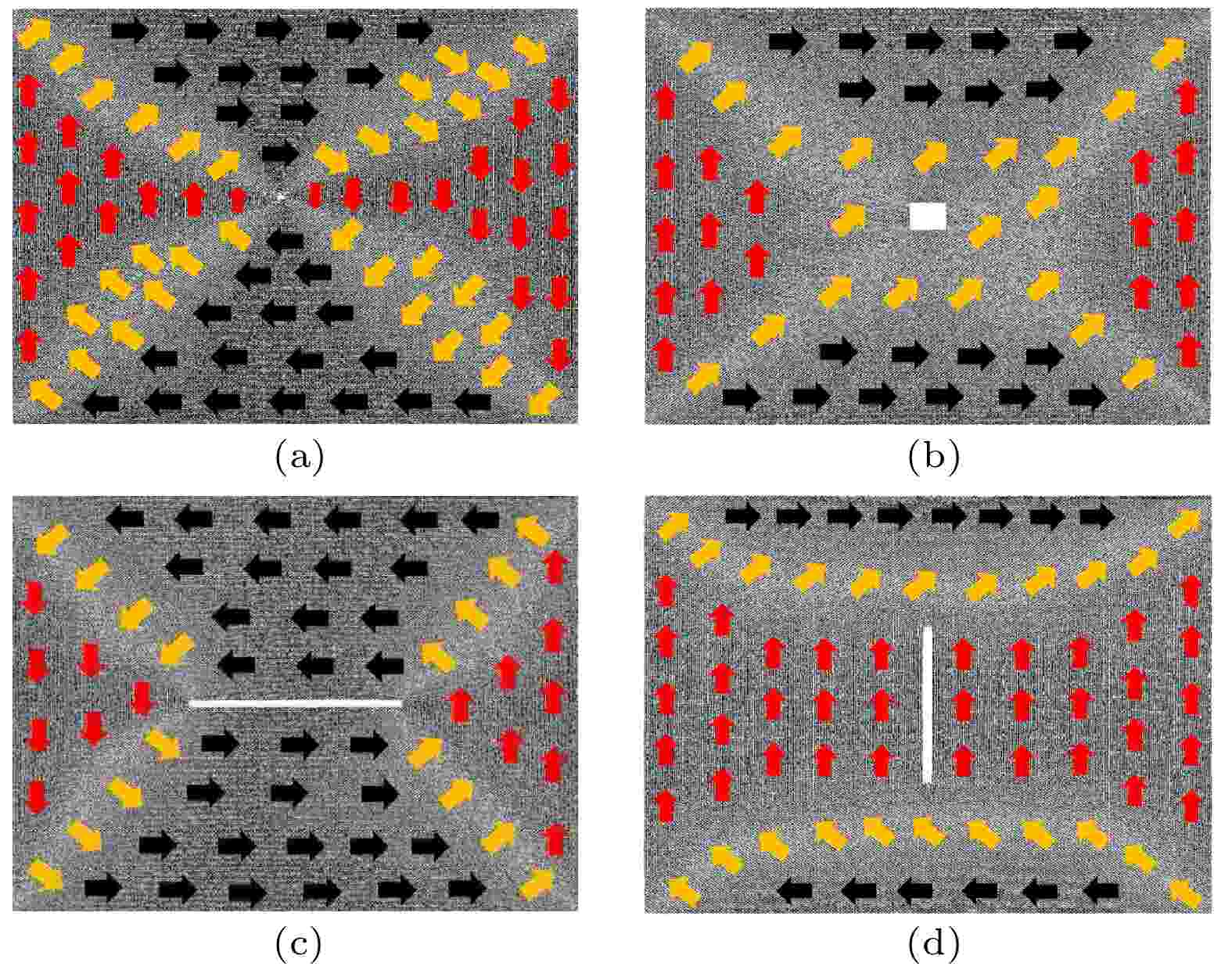
EDITOR'S SUGGESTION
2022, 71 (1): 017502.
doi: 10.7498/aps.71.20211177
Abstract +
Magnetostrictive materials have broad application prospects in sensing, control, energy conversion, and information conversion. The improving of the performances and applications of such materials has become a research hotspot, but defects will inevitably appear in the preparation and use of materials. In this study, the magnetostrictive structure model of iron elemental material with no defect or hole defect or crack defect is established by the molecular dynamics method. The influences of different defects on the magnetostrictive behavior of iron thin films are analyzed, and the mechanism of the influence of defects on the magnetostrictive behavior is depicted from the perspective of atomic magnetic moment. The results show that the films with 60 × 2 × 1 defects in the center are the easiest to reach saturation magnetostriction, and the magnetostriction is the least after reaching saturation, with respect to the films without defects. The films with 10 × 10 × 1 and 2 × 60 × 1 defects in the center require a larger magnetic field to approach to saturation, and the magnetostriction of the film with 2 × 60 × 1 defects in the center reaches a maximum value after saturation. This is because the defects will affect the magnetic moment of the surrounding atoms and make them deflect to the direction parallel to the defects, thus affecting the magnetostriction of the iron thin film. Among them, the hole defects have less influence on the magnetostriction, while the crack defects have stronger influence on the magnetostriction. The direction of the crack also has an effect on the magnetostriction of Fe thin film. When the crack is parallel to the direction of magnetization, the maximum magnetostriction of the film in the direction of magnetization from the initial state to the saturation of magnetization will decrease. When the crack is perpendicular to the direction of magnetization, the maximum magnetostriction of the film in the direction of magnetization from the initial state to the saturation of magnetization will increase. These results suggest that the defects affect the magnetostriction of the model as a whole during magnetization by affecting the initial magnetic moment orientation of the surrounding atoms.

2022, 71 (1): 017801.
doi: 10.7498/aps.71.20211313
Abstract +
The multi-energy composite field micro-electrodeposition processing technology is used to prepare colorful structural coloration magnetic Al2O3-Co composite films each with a gradual microstructure. Under the action of the deposition electric field and the deflection electric field perpendicular to it, the microstructure, optical properties and magnetic properties of the composite films show gradual characteristics along the direction of the deflection electric field. By establishing an equivalent model of the microstructure, the mechanism of the microstructure change of the composite film is theoretically analyzed. Through software simulation, the distribution of Co ion deposition current density along the direction of the deflection electric field is quantitatively analyzed. The simulation results are consistent with the theoretical and experimental results. Through this study, we find that the micro-electrodeposition processing technology with using multi-energy field composite can control the micro-domain structure of the composite film from a microscopic point of view, and achieve the fine control of the magnetic and optical properties of the film micro-domain.
INTERDISCIPLINARY PHYSICS AND RELATED AREAS OF SCIENCE AND TECHNOLOGY

2022, 71 (1): 018201.
doi: 10.7498/aps.71.20211100
Abstract +
Supercapacitors have attracted extensive attention in various storage devices due to their high power density, long life and friendly environment. Hence, improving the energy storage performances of electrode materials are of great significance for supercapacitors. Functional materials with specific nanostructures, as energy storage materials, can display excellent electrochemical performances, for they will provide rich electrochemically active sites, high specific surface area and enhance electrolyte contact area. Consequently, hollow cage-like nickel cobalt layered hydroxides (NiCo-LDH) are prepared via nitrate etching of ZIF-67 nanocrystals, and investigated as electrode materials of supercapacitor. The morphology, structure and electrochemical properties of the obtained materials are investigated by X-ray diffraction, scanning electron microscope, transmission electron microscope, N 2 adsorption/desorption and a series of electrochemical tests (including cyclic voltammetry, galvanostatic charge and discharge and AC impedance). The results show that the NiCo-LDH samples assembled by nanosheets present a porous structure with hollow cages and high specific area surfaces, which conduces to increasing the electroactive sites, enhancing the contact between the electrolyte and the electrode material, and thus significantly improving the electrochemical performance of the materials. With the mass ratio of nickel to cobalt salt being 1∶1, the specific capacitance of Ni 1Co 1-LDH is 801 F·g –1 at a current density of 0.5 A·g –1, and a specific capacitance of 582 F·g –1 can still be maintained at a high current density of 10 A·g –1. Moreover, the specific capacitance retention of Ni 1Co 1-LDH is 100.2% after 2000 cycles at a current density of 15 A·g –1, displaying good electrochemical performance and great potential in supercapacitor applications.
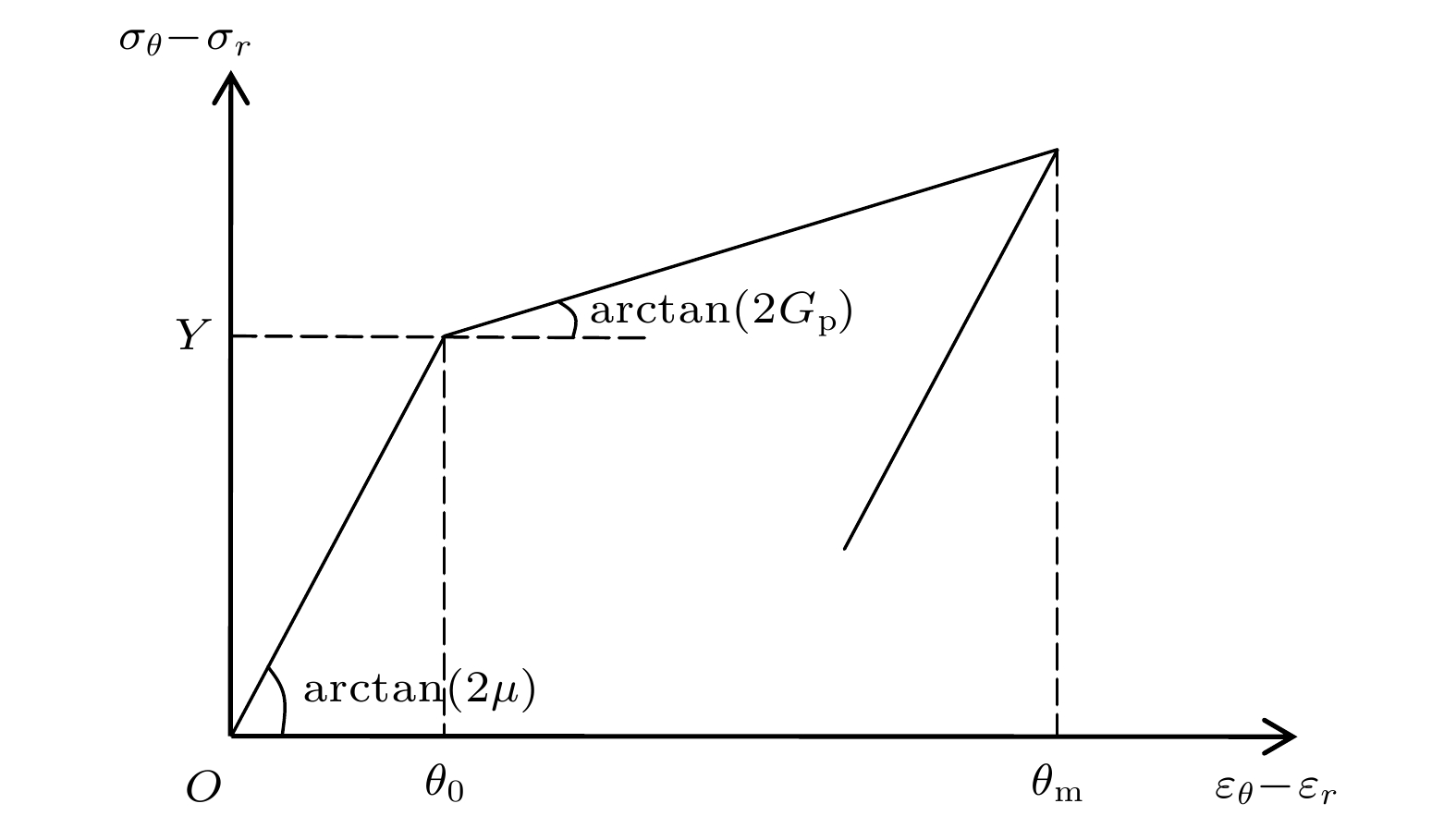
EDITOR'S SUGGESTION
2022, 71 (1): 018301.
doi: 10.7498/aps.71.20210954
Abstract +
Based on the linear hardening plastic constitutive model, the theoretical solution of the elastic-plastic spherical stress wave field under impact load is established. Firstly, the influence of the impact load unloading rate on the propagation of the spherical stress wave is analyzed, and three different types of propagation images are obtained. On this basis, the method of theoretically calculating the spherical wave equation in elastic stage, plastic loading stage and unloading stage is established separately, and the calculation scheme of particle displacement, particle velocity, stress and strain is given. Compared with the existing theoretical methods, this method takes into account the different propagation patterns of the stress waves under different unloading rates, and shows how to calculate the stress wave parameters in unloading stage, which is more applicable. This method is used to calculate the elastic-plastic spherical stress wave field under constant shock load and exponential attenuation shock load. The calculated results are in good agreement with those from the existing theoretical method and numerical simulation results in the elastic stage and also in the plastic loading stage. In the unloading stage, the existing theoretical method is no longer applicable, while the results obtained in this paper are in good agreement with the numerical simulation results, which verifies the correctness of the theoretical method.
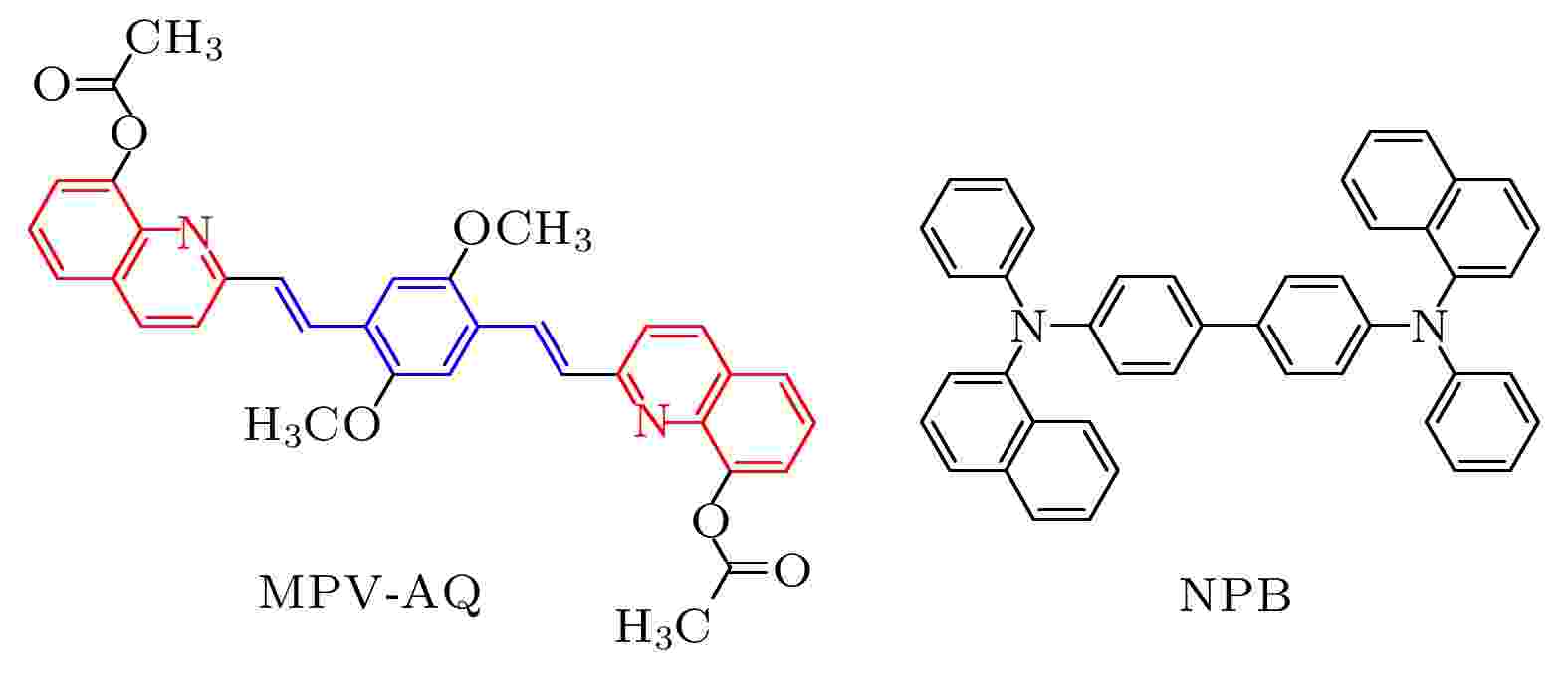
EDITOR'S SUGGESTION
2022, 71 (1): 018501.
doi: 10.7498/aps.71.20211171
Abstract +
Styrene and quinoline groups are commonly incorporated into the organic fluorescent materials for organic light-emitting diodes (OLEDs). In this work, a type of small molecule derived from styrene and quinoline, with a chemical structure of 2,2'-(2,5-dimethoxy-1,4-phylenedivinylene)bis-8- acetoxyquinoline (MPV-AQ), is employed as the emitter and electron transporting material in the OLEDs, and its optoelectronic characteristics such as charge-carrier injection, transporting and recombination are investigated by the steady-state and transient technologies. It is found that the electron injection from the cathode into the MPV-AQ layer shows the Fowler-Nordheim (FN) tunneling characteristic in the N,N'-di(naphthalene-1-yl)-N,N'-diphenyl-benzidine (NPB)/MPV-AQ bilayer OLED, which is different from the Richardson-Schottky (RS) thermionic emission in the electron-only device based on the MPV-AQ single-layer. The difference in electron injection is attributed to the bend of energy bands of MPV-AQ in the NPB/MPV-AQ device, which can be caused by the charge accumulation at the NPB/MPV-AQ interface. The accumulated charges should mainly be the holes on the side of NPB layer because the electron mobility of MPV-AQ is much lower than the hole mobility of NPB. Owing to the bending of lowest unoccupied molecular orbital (LUMO) of MPV-AQ, the tunneling distance for electrons is significantly reduced, which is favorable for the FN tunneling. The barrier height for electron injection is calculated to be 0.23 eV by fitting the current-voltage curve of the NPB/MPV-AQ bilayer OLED. And the electron mobility of MPV-AQ is determined by the delay time of transient electroluminescence (EL) and shows field-dependence with the value on the order of 10–6 cm2/(V·s). In addition, the electron-hole recombination coefficient is obtained from the long time component of the temporal decay of the EL intensity, and the coefficient is found to decrease with the applied voltage increasing, which is consistent with the efficiency roll-off in this bilayer OLED. This study may provide a foundation for understanding the electronic processes of carrier injection, transport and recombination in the OLEDs, which is helpful in improving the device performance.
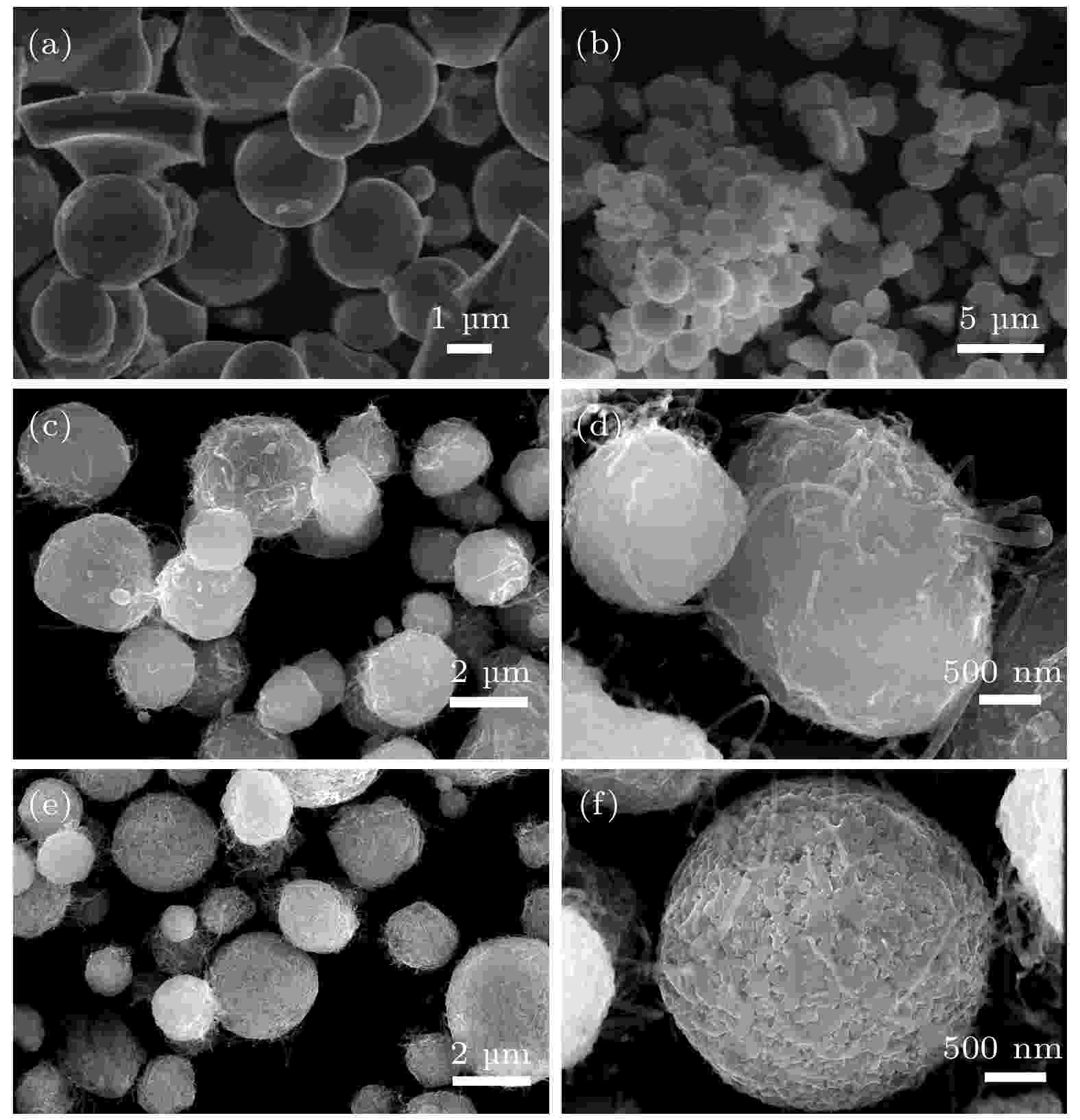
2022, 71 (1): 018801.
doi: 10.7498/aps.71.20211043
Abstract +
The spherical composite powders of multi-walled carbon nanotubes reinforced alumina are prepared by sol- spray. The results show that the multi-walled carbon nanotubes are well dispersed in the composites. The analyses of the composite properties show that most of the multi-walled carbon nanotubes are distributed in a network at the grain boundaries, and a small number of them are distributed in the grains. When the mass fraction of multi-walled carbon nanotubes accounts for 0.5%, the Vickers hardness of the composite increases by 32.6% relative to pure alumina; the thermal diffusion coefficient increased averagely by 27.2% with respect to pure alumina at different temperatures. The composites are conductive at 0.5% of multi-walled carbon nanotubes, and the percolation threshold of the composites prepared by this method is 0.32wt.% based on the fitting of the percolation conductivity theory, indicating that the multi-walled carbon nanotubes are well dispersed in the alumina matrix.

2022, 71 (1): 018802.
doi: 10.7498/aps.71.20211074
Abstract +








